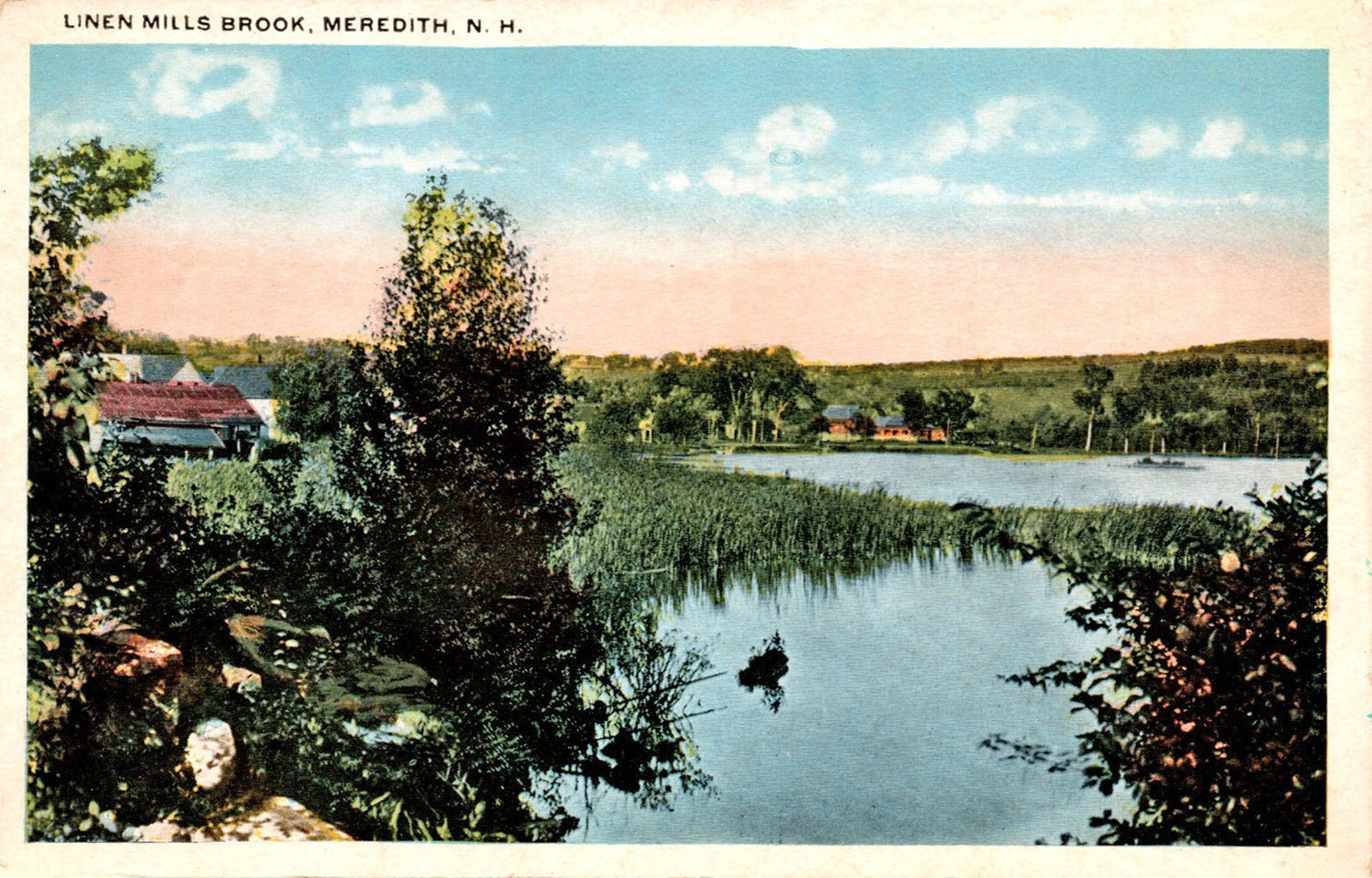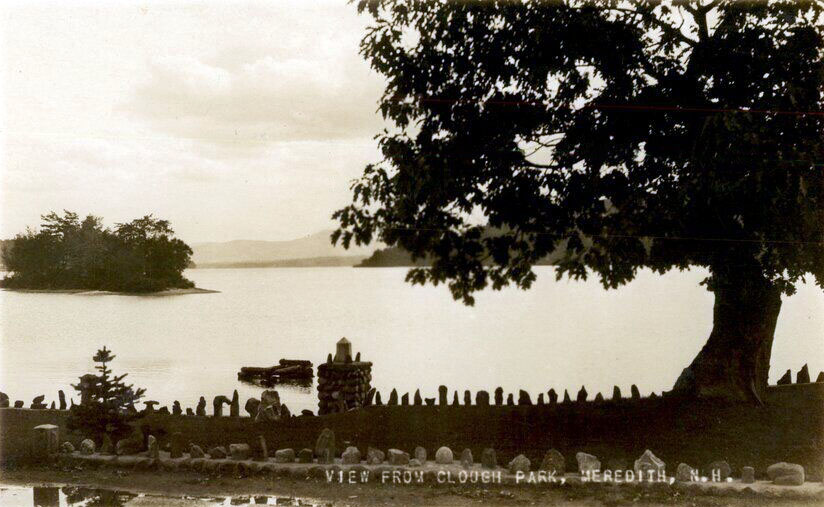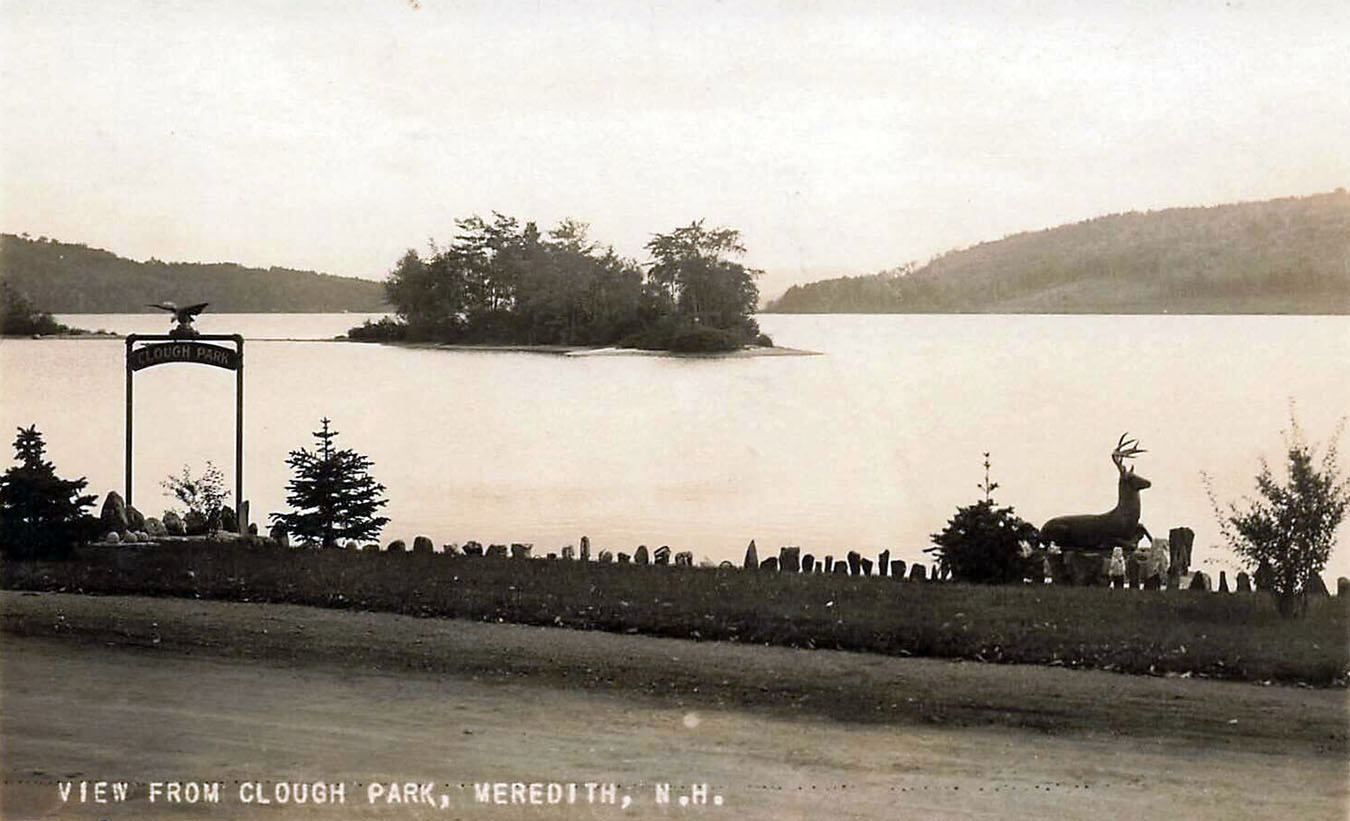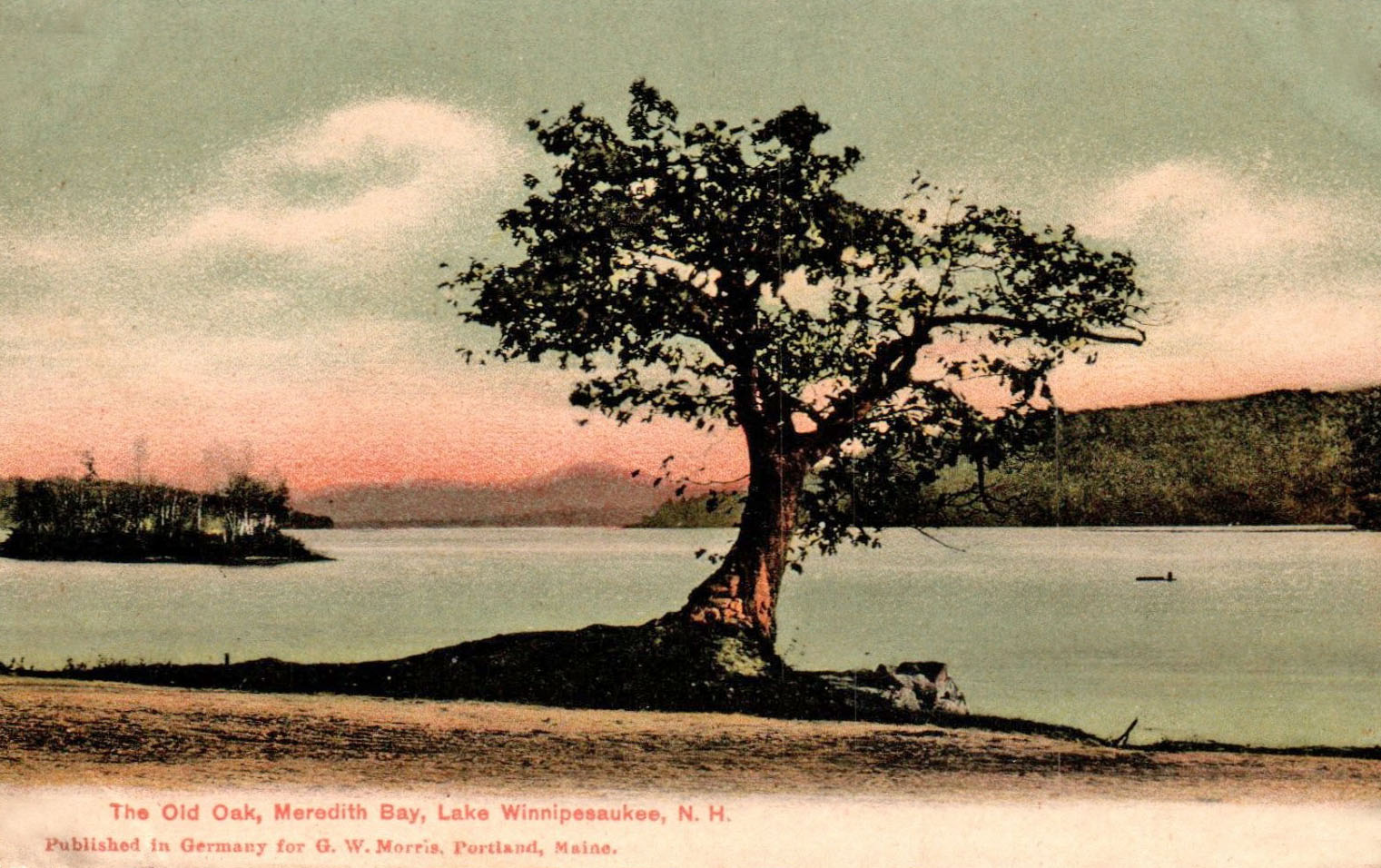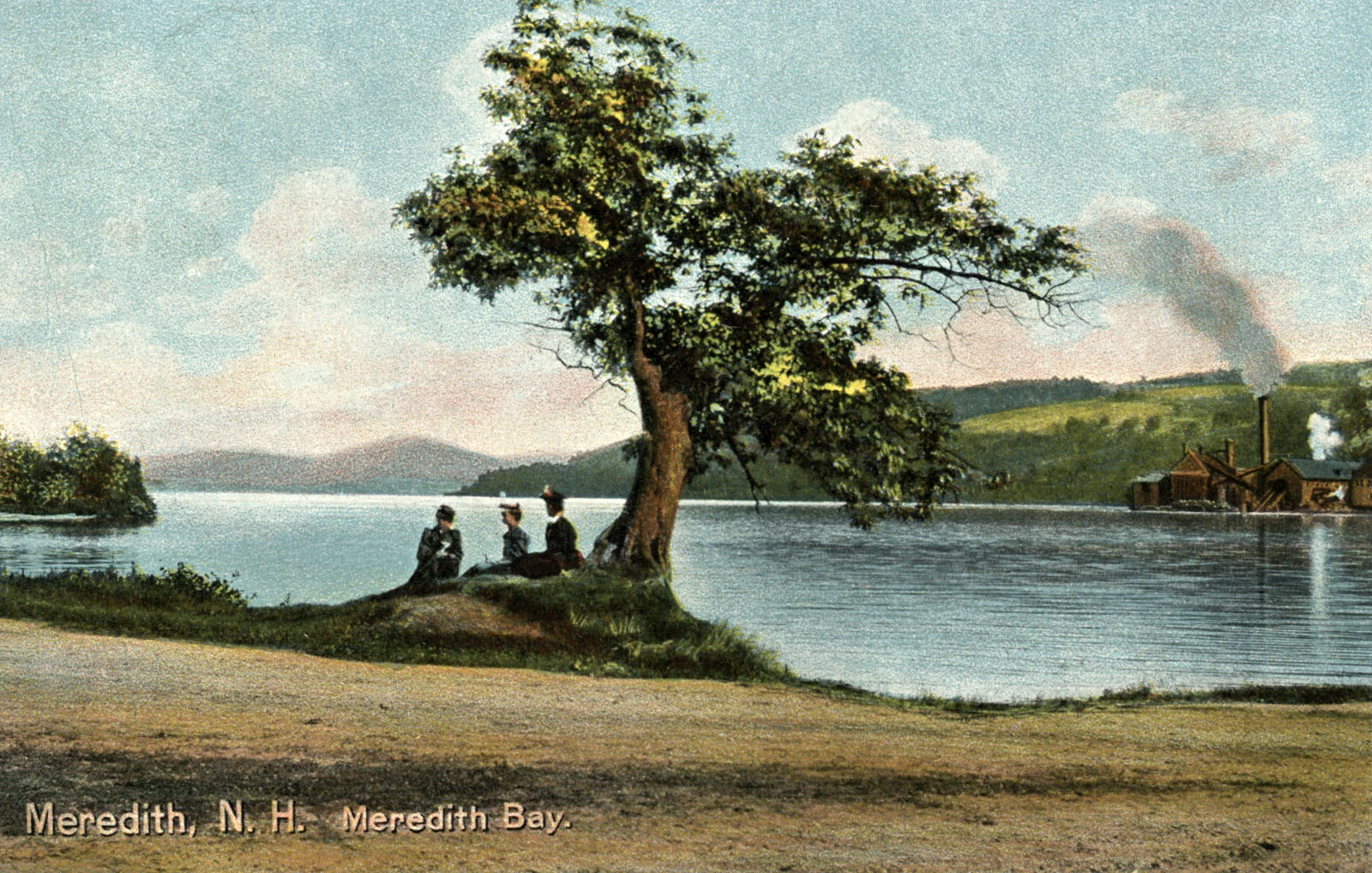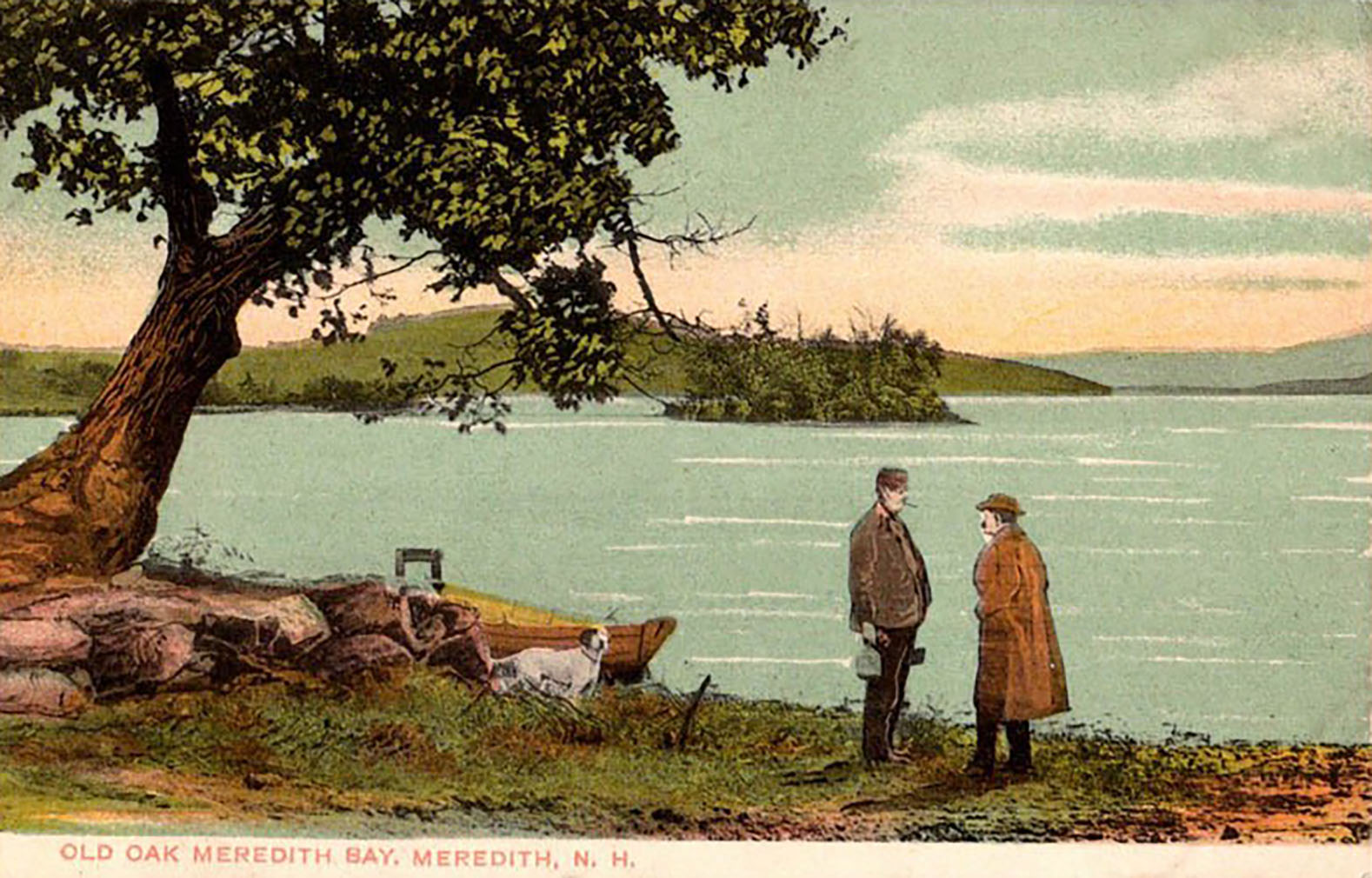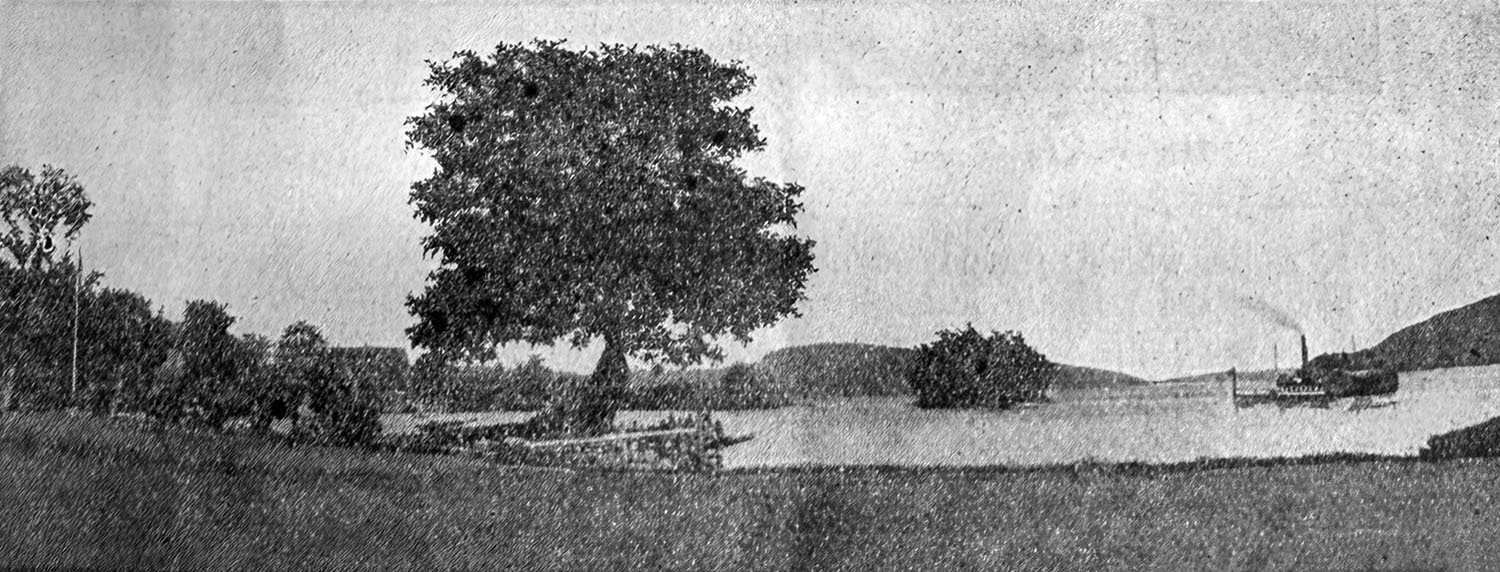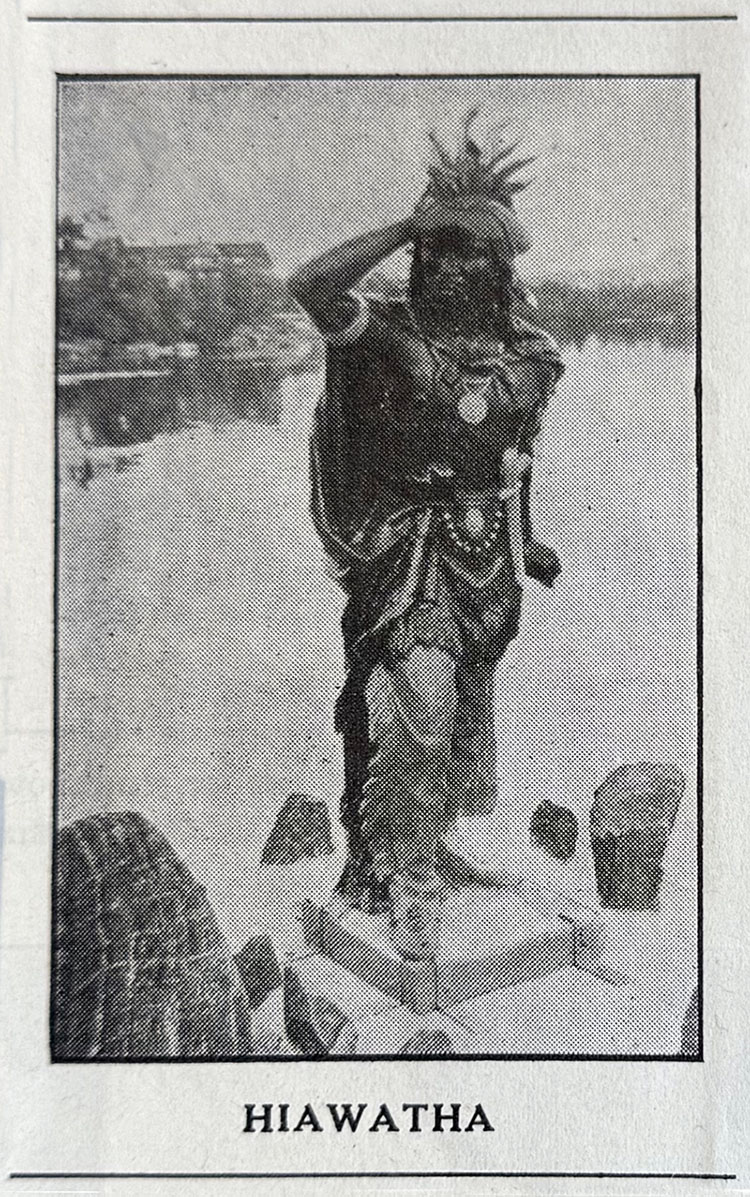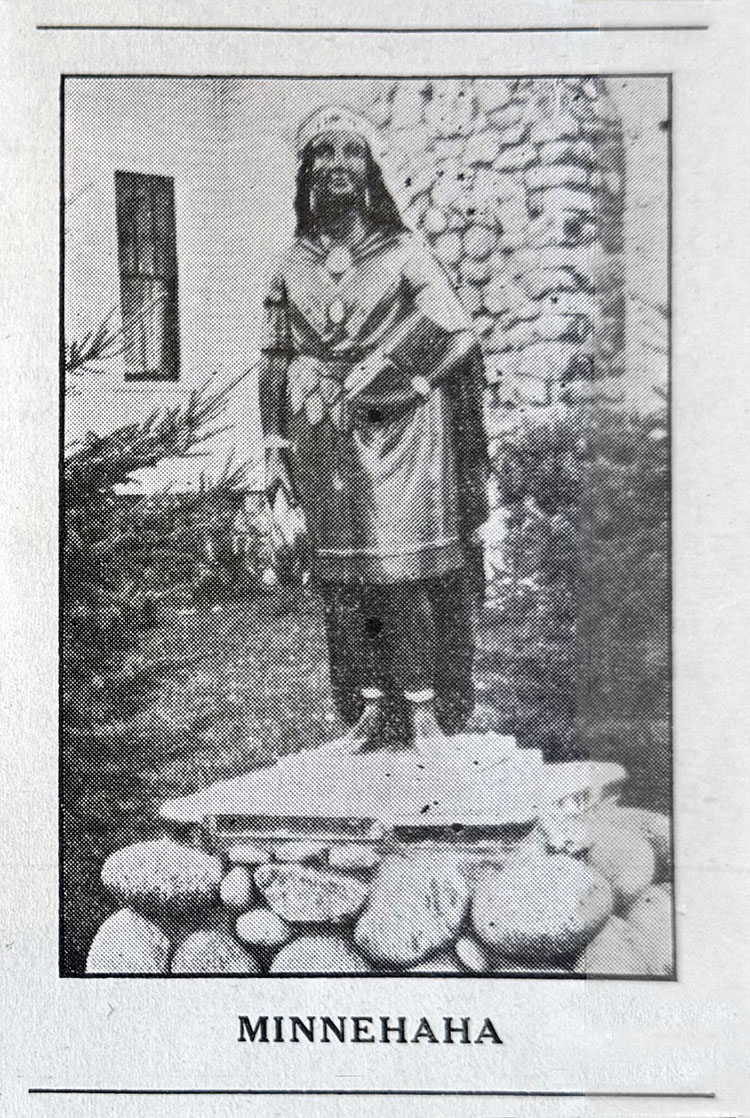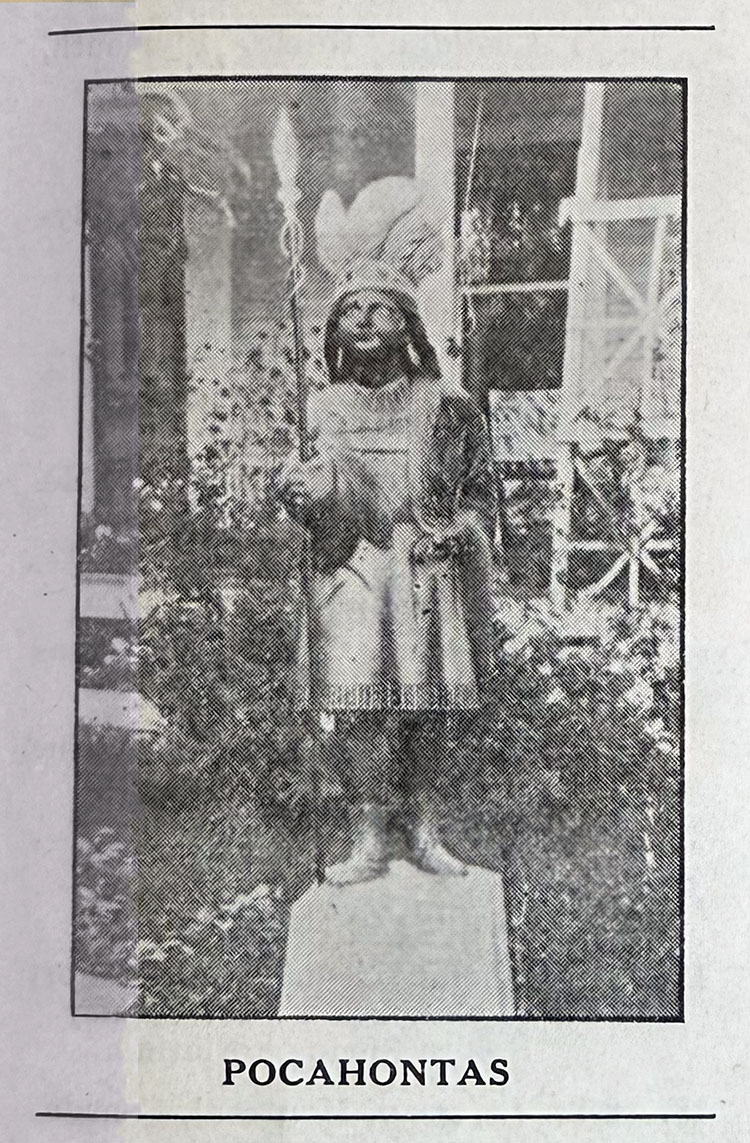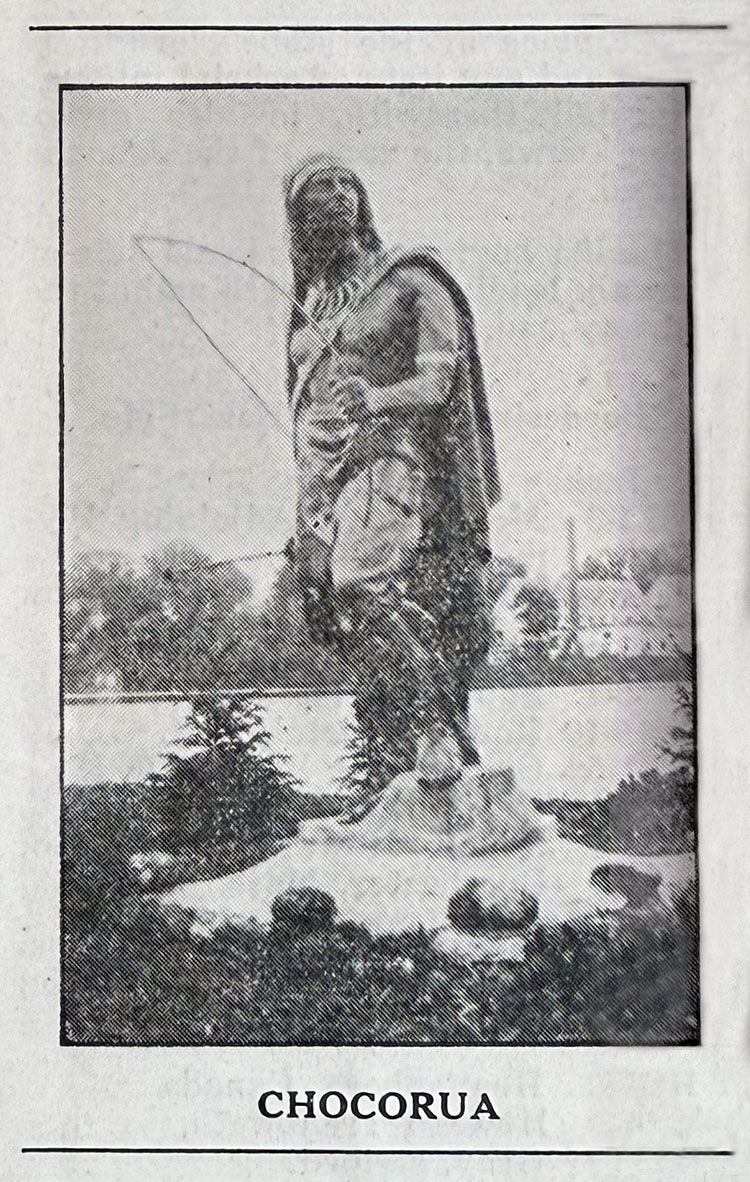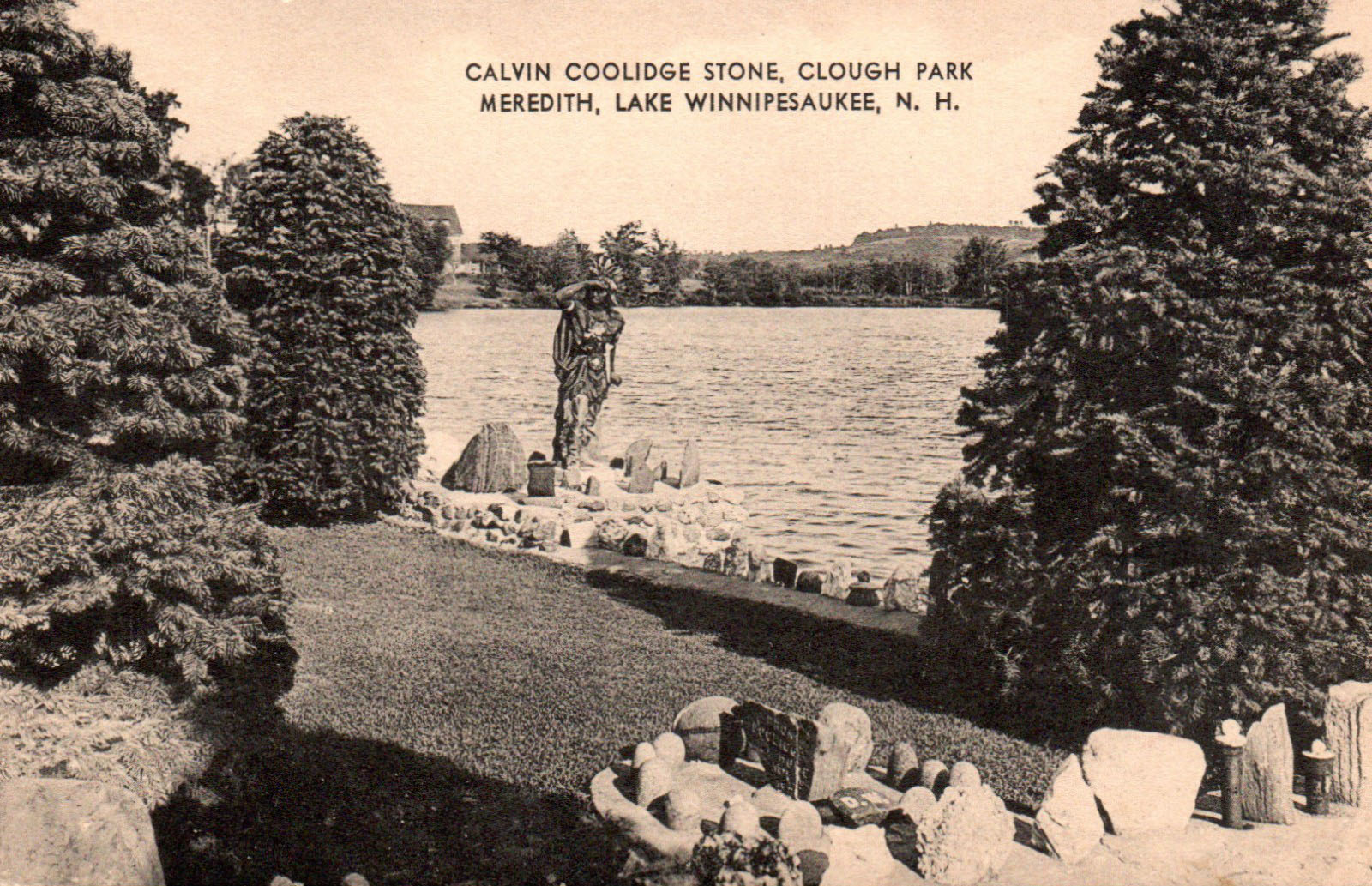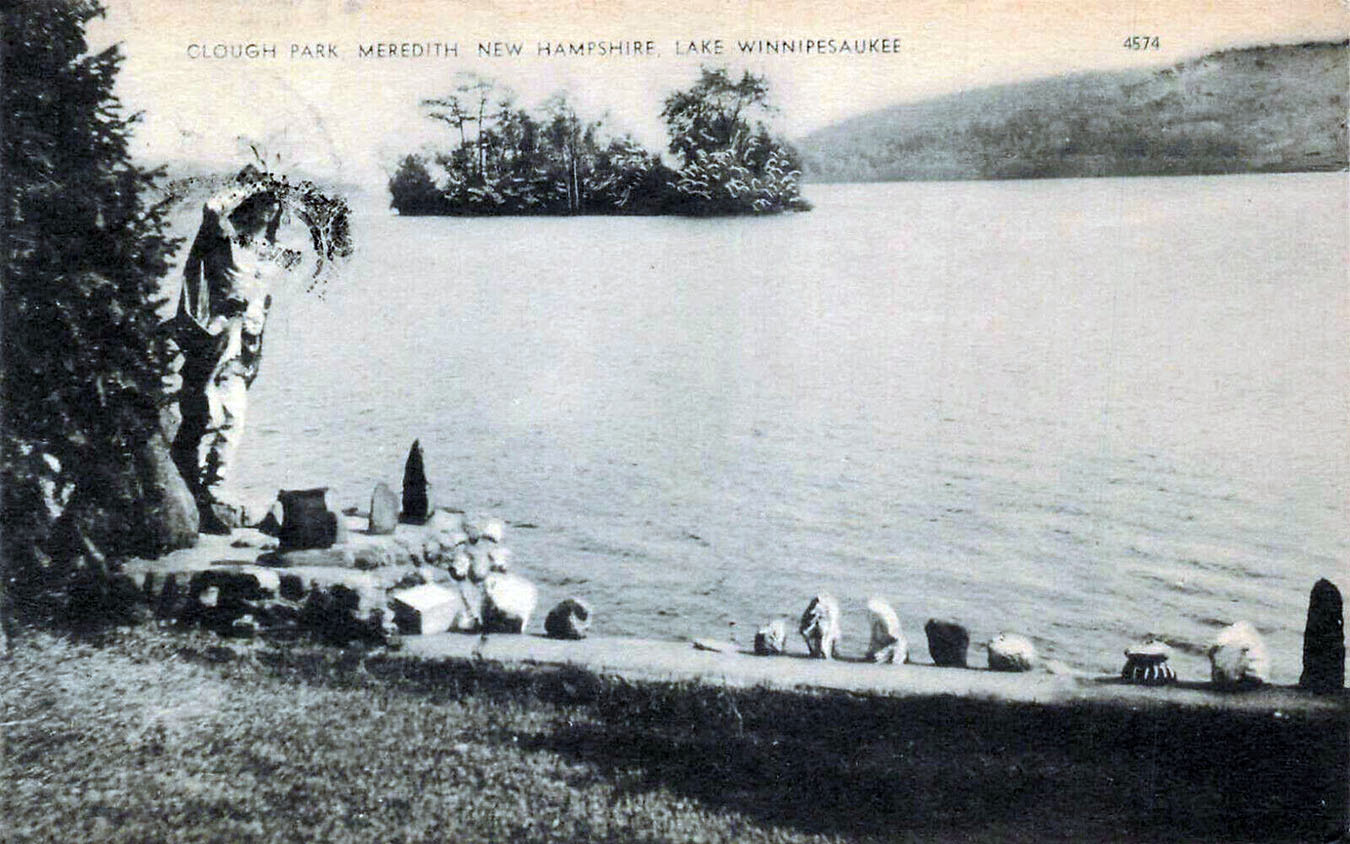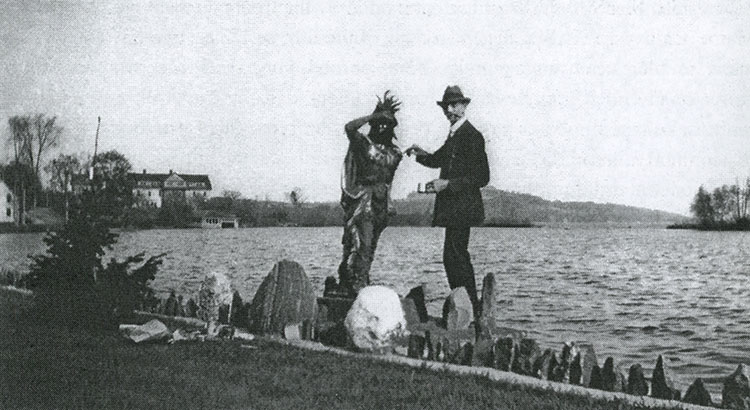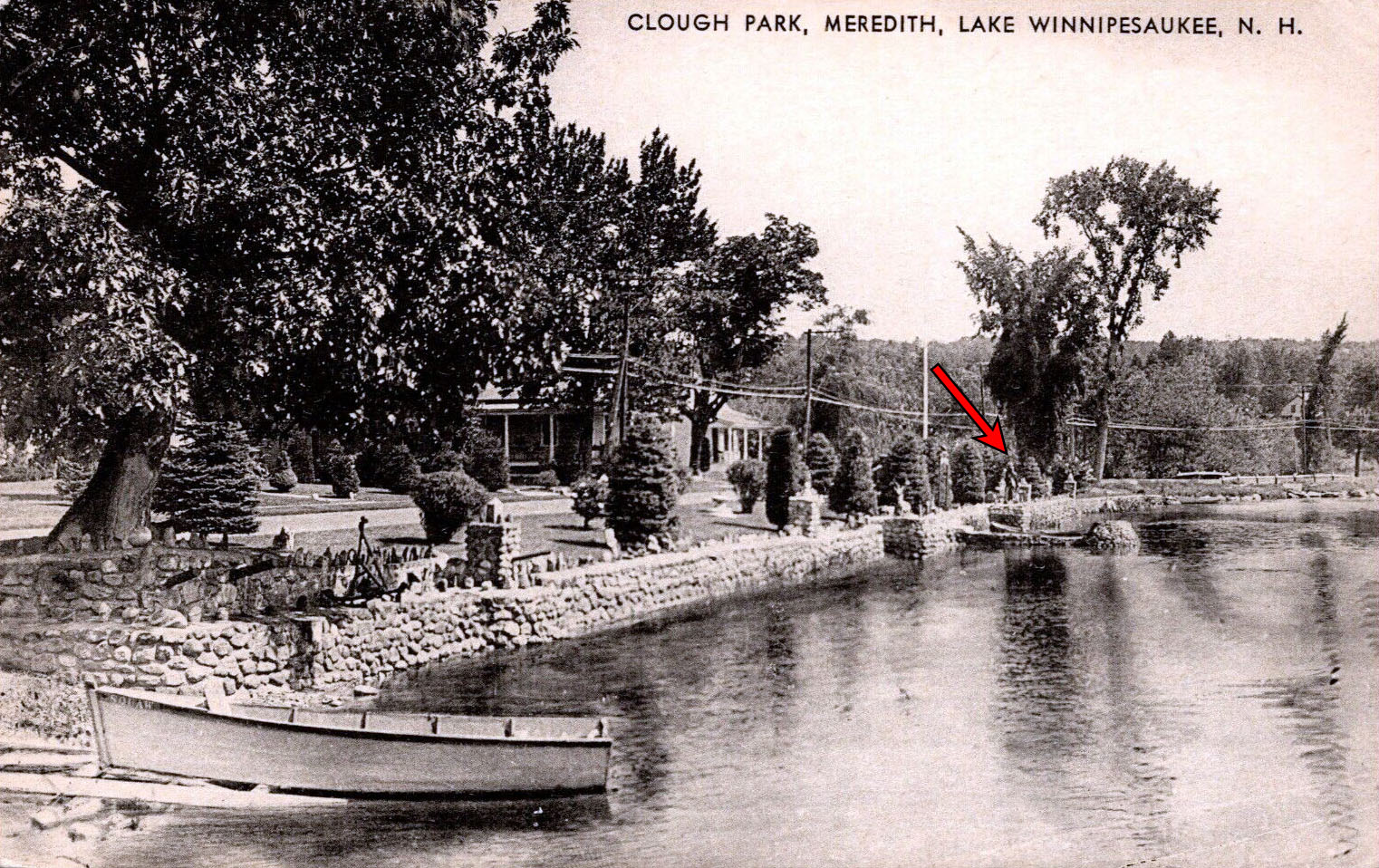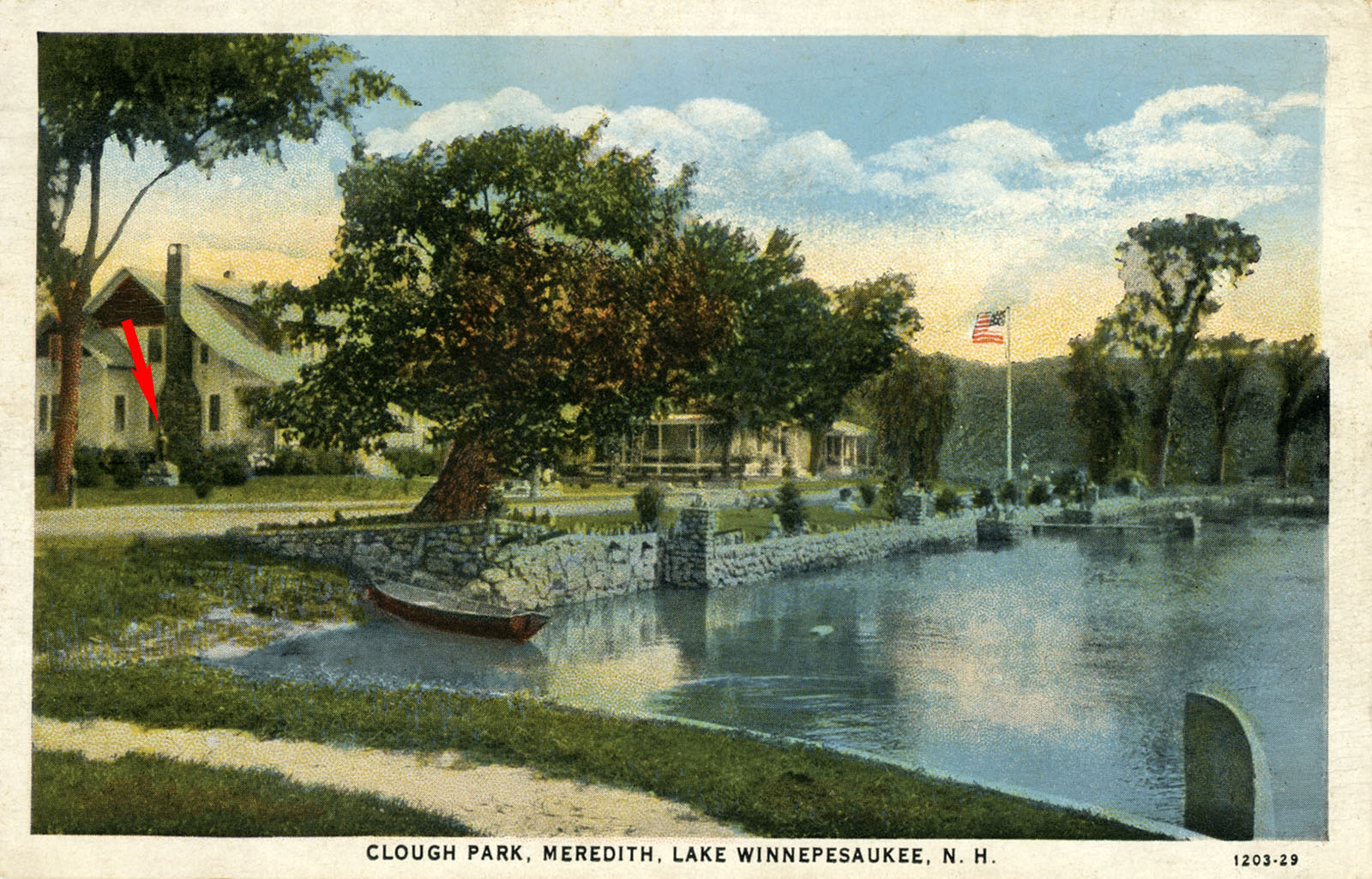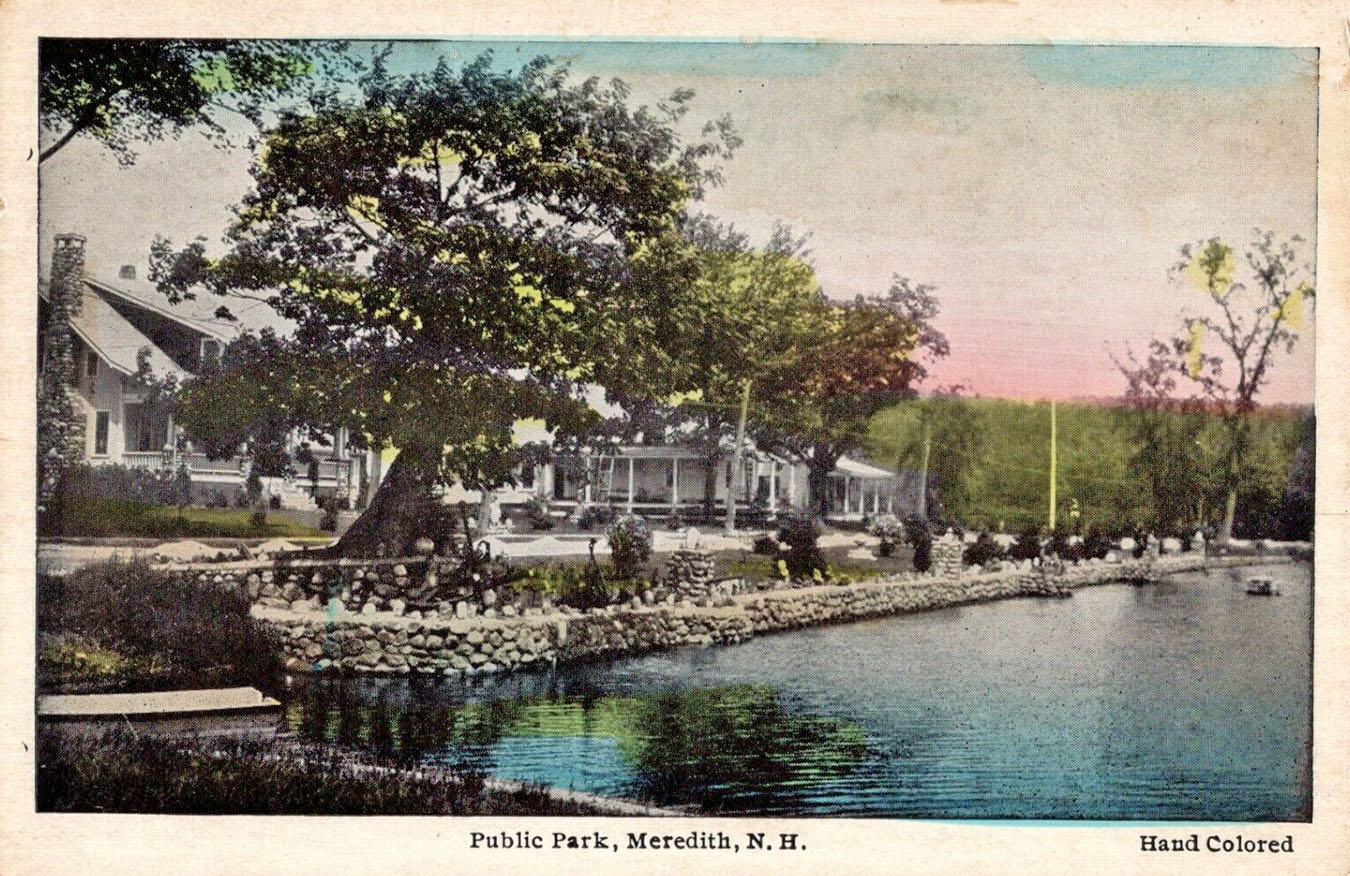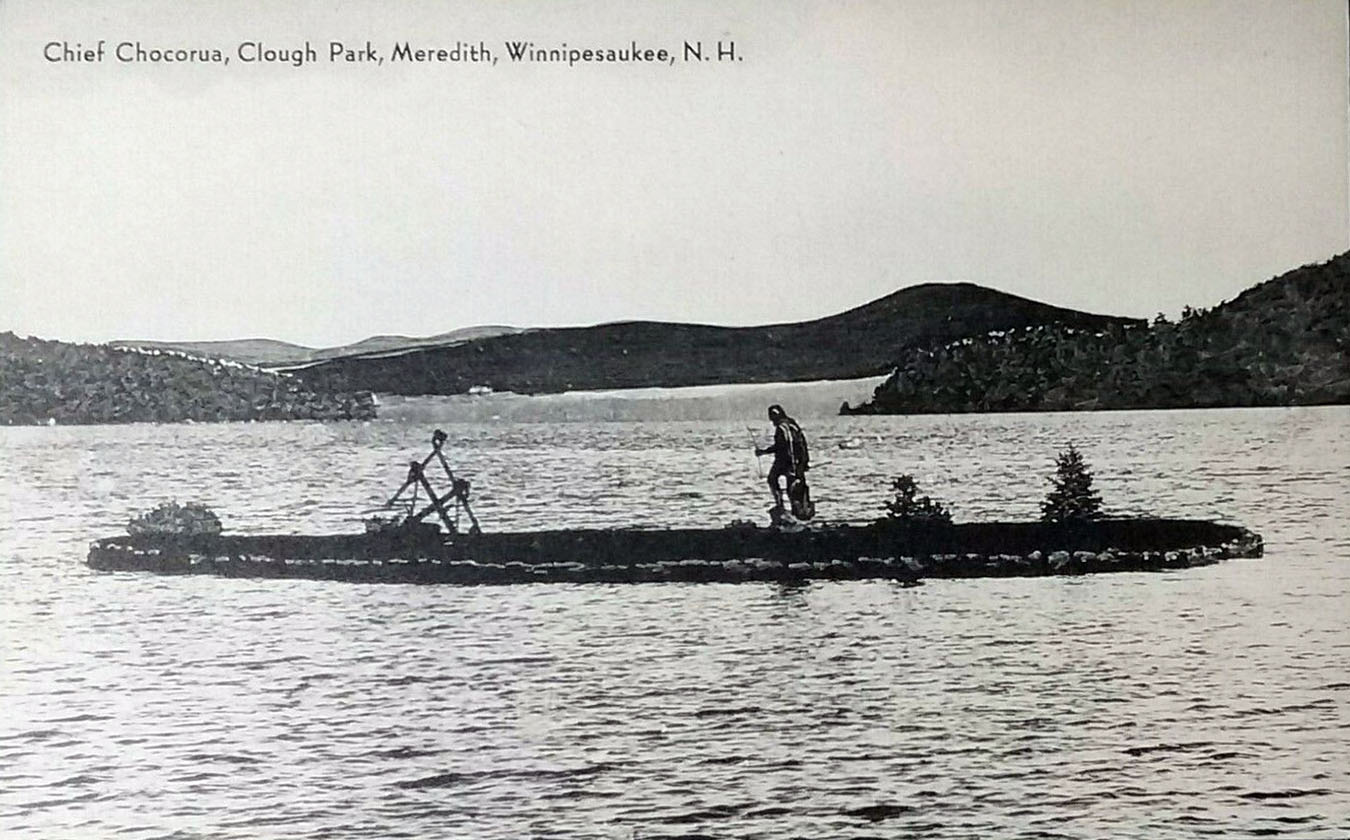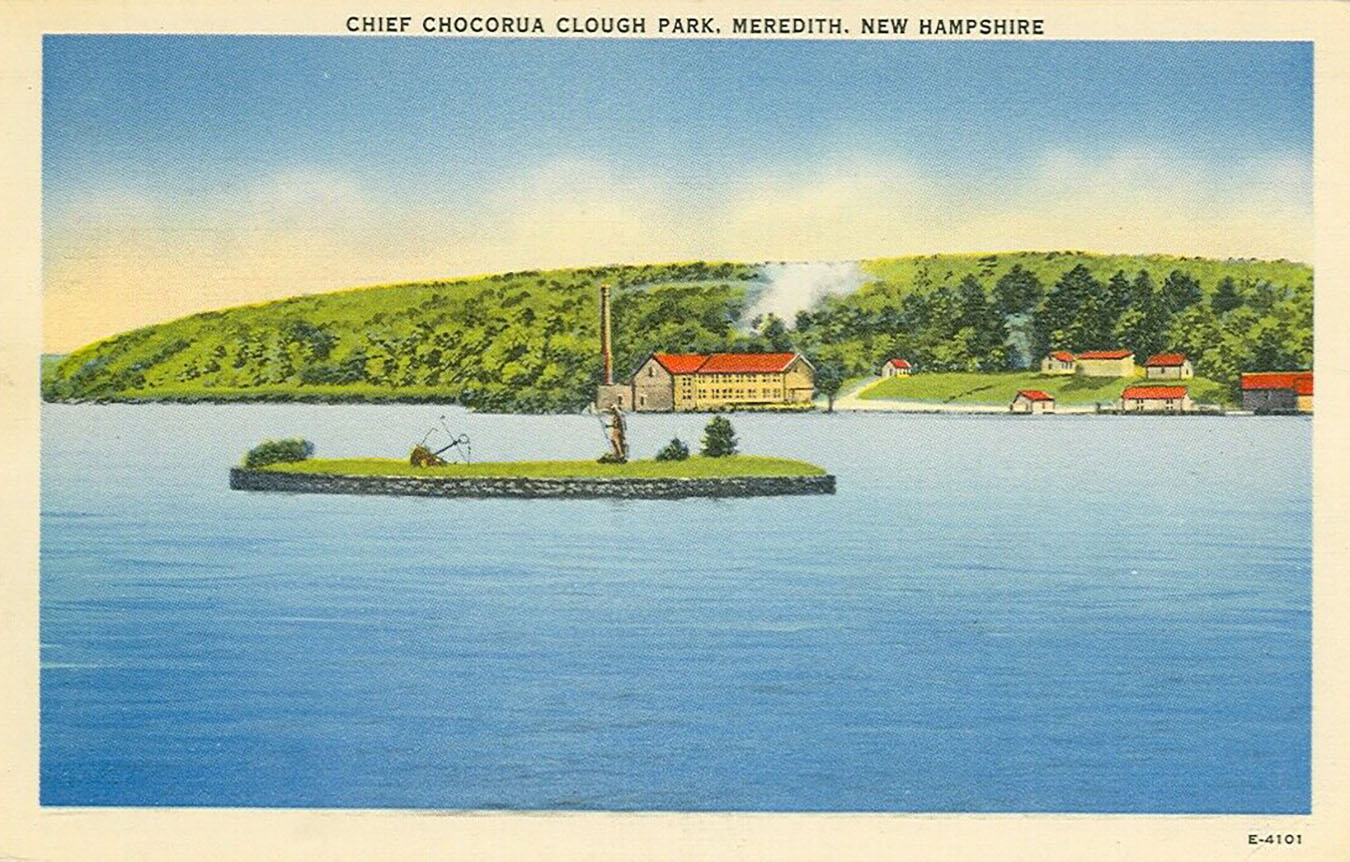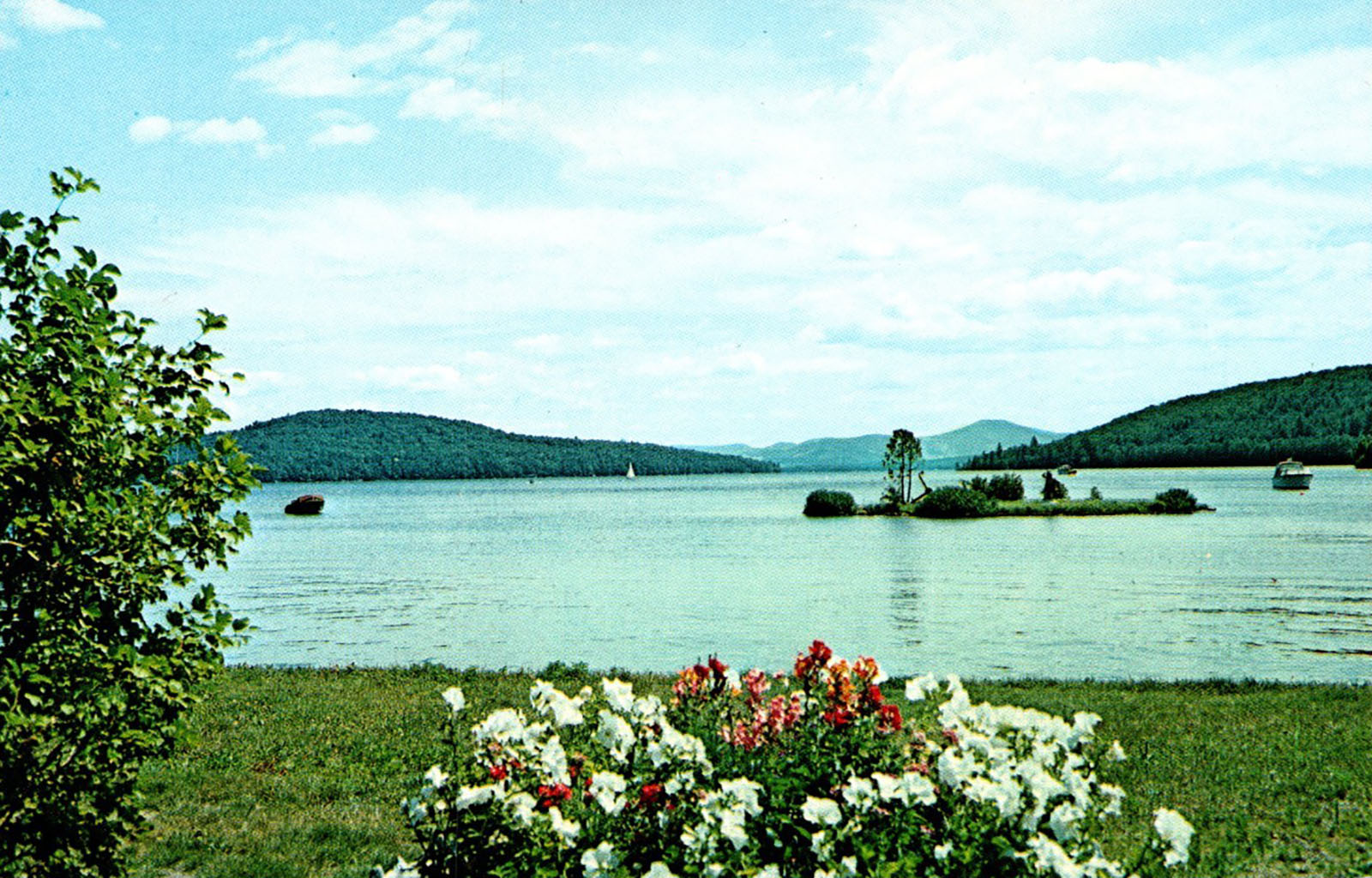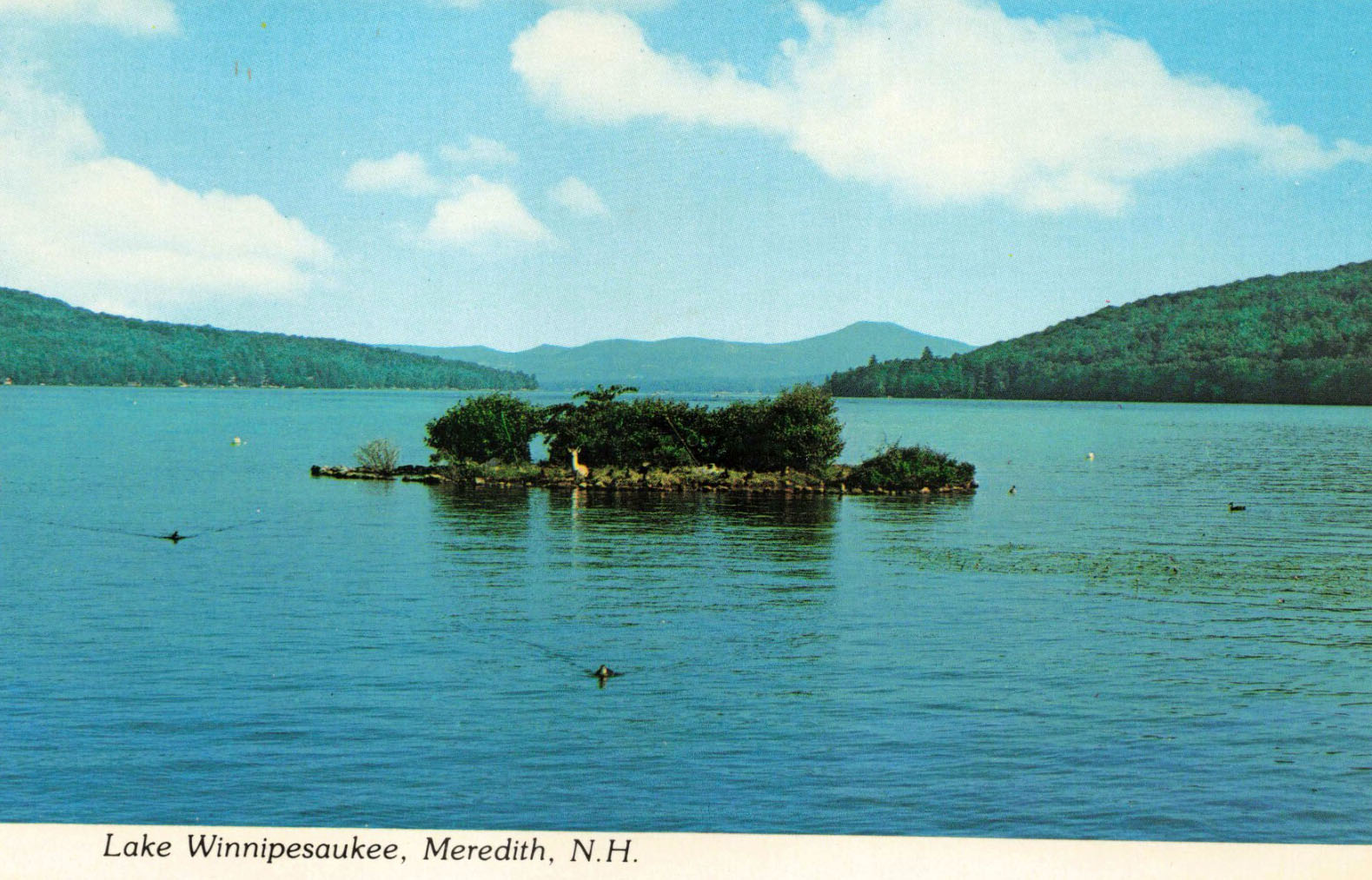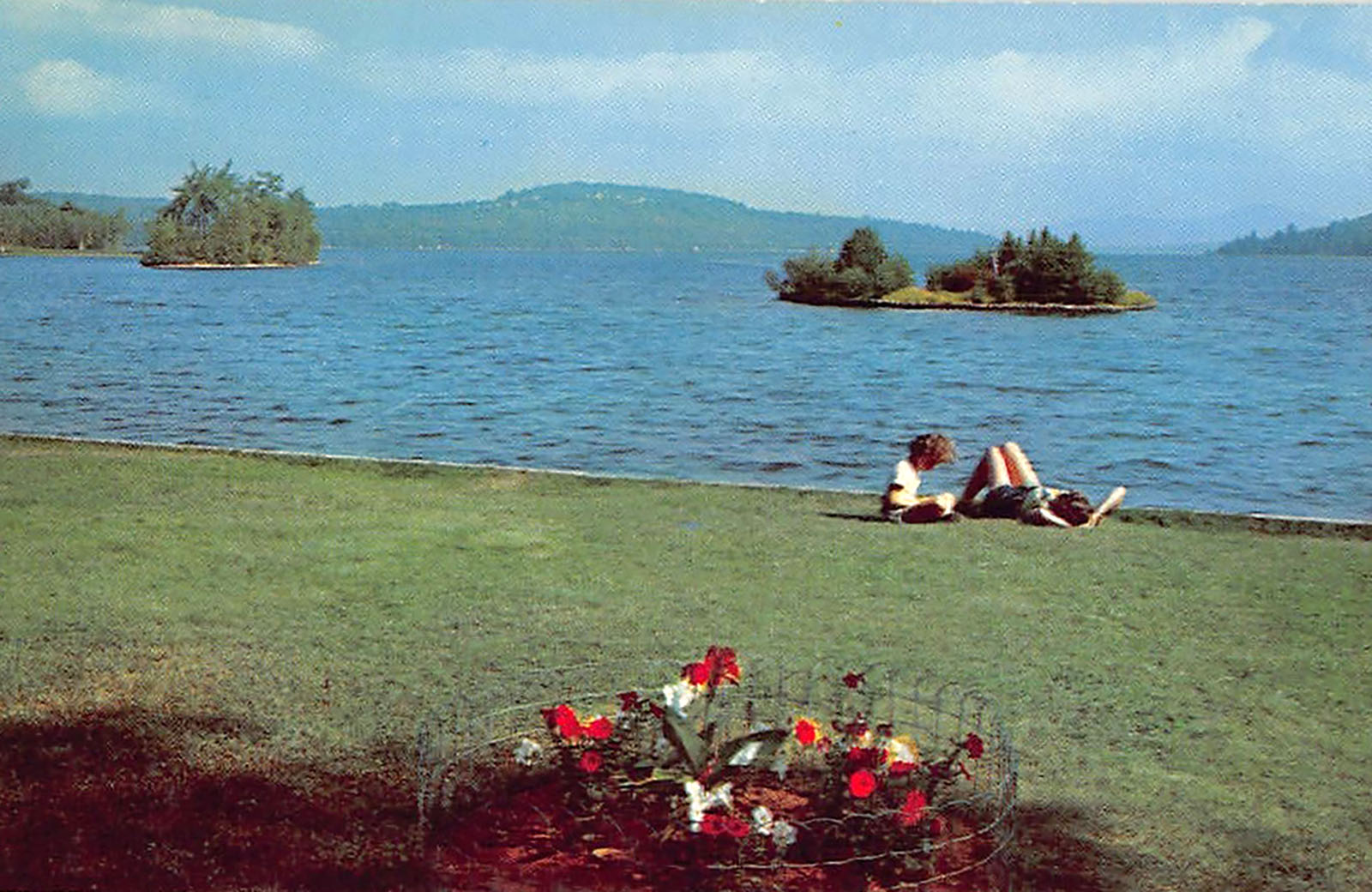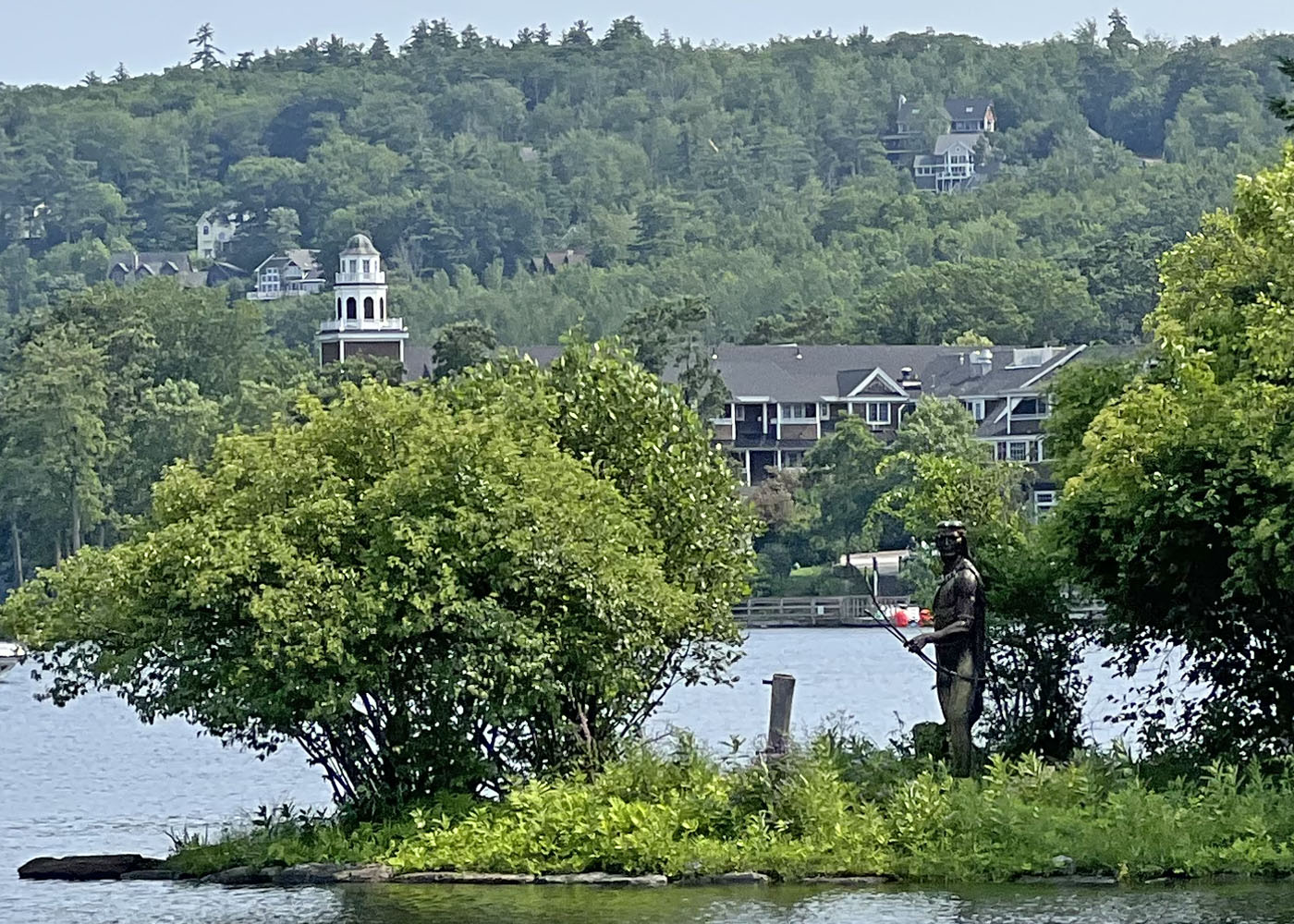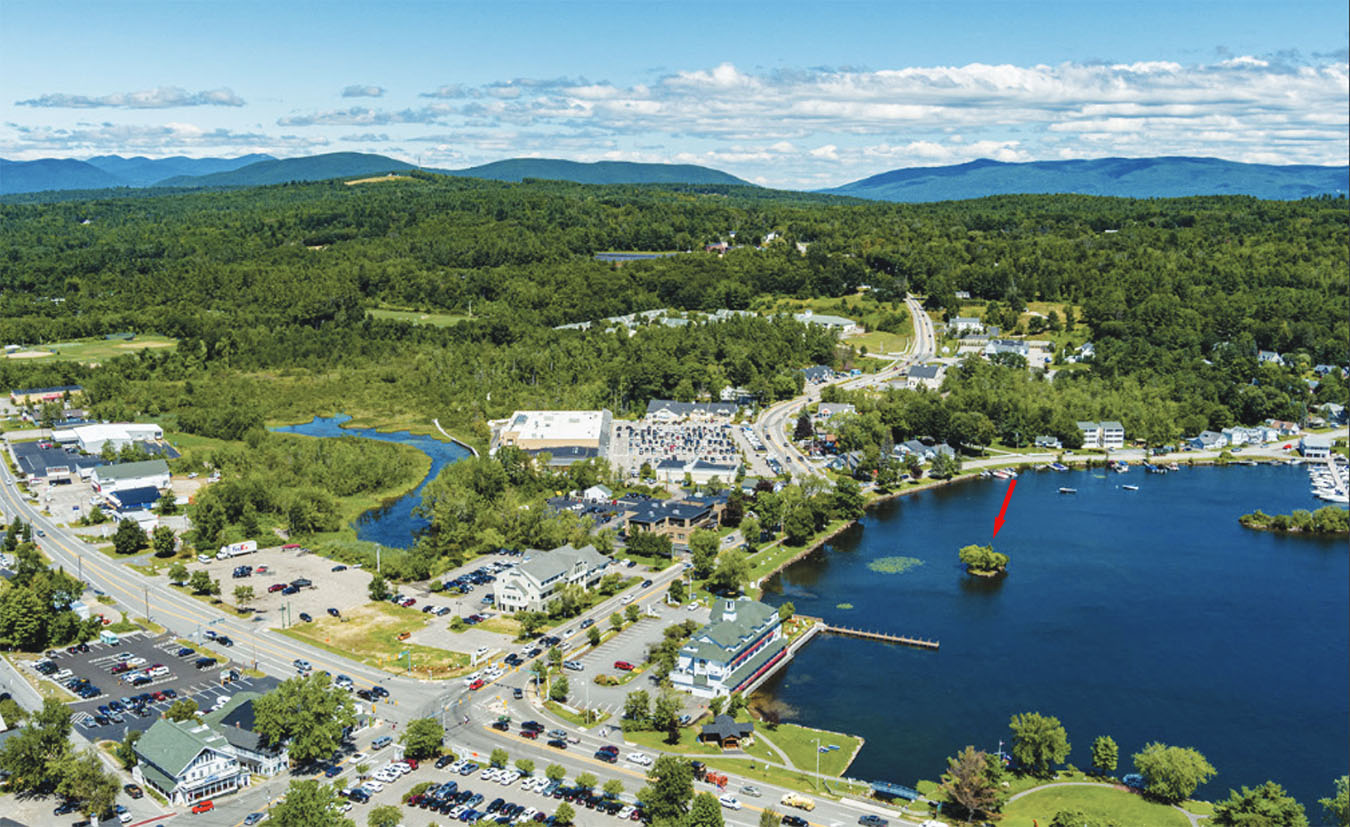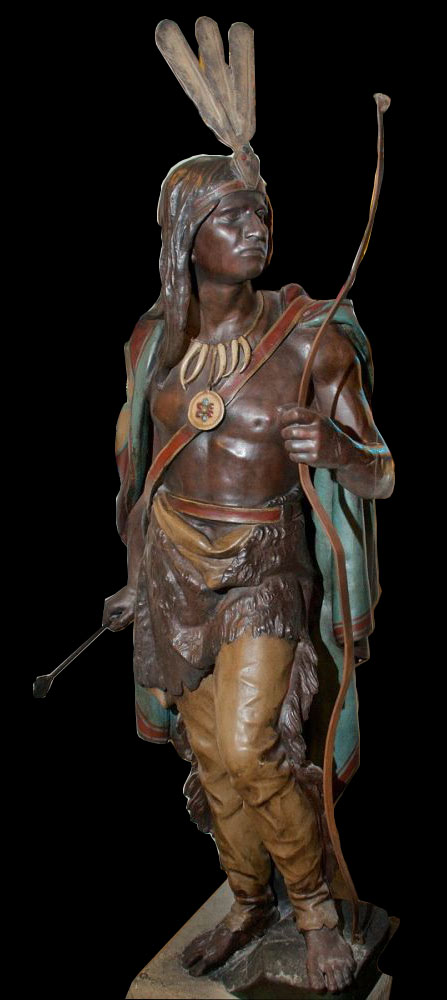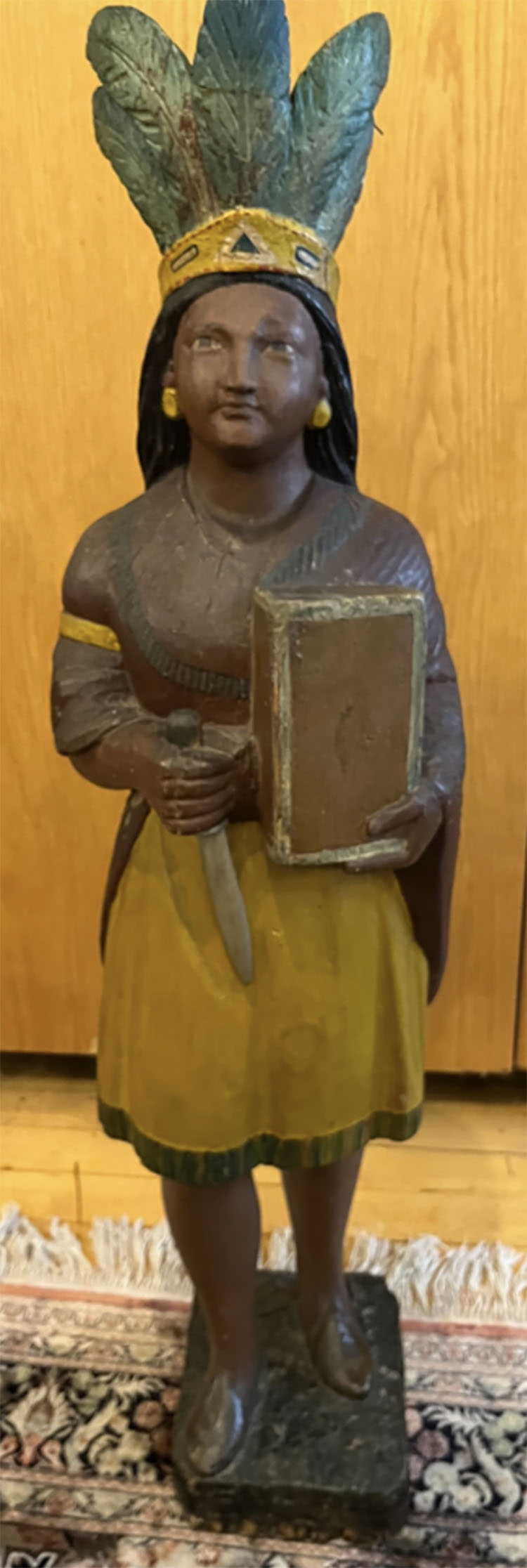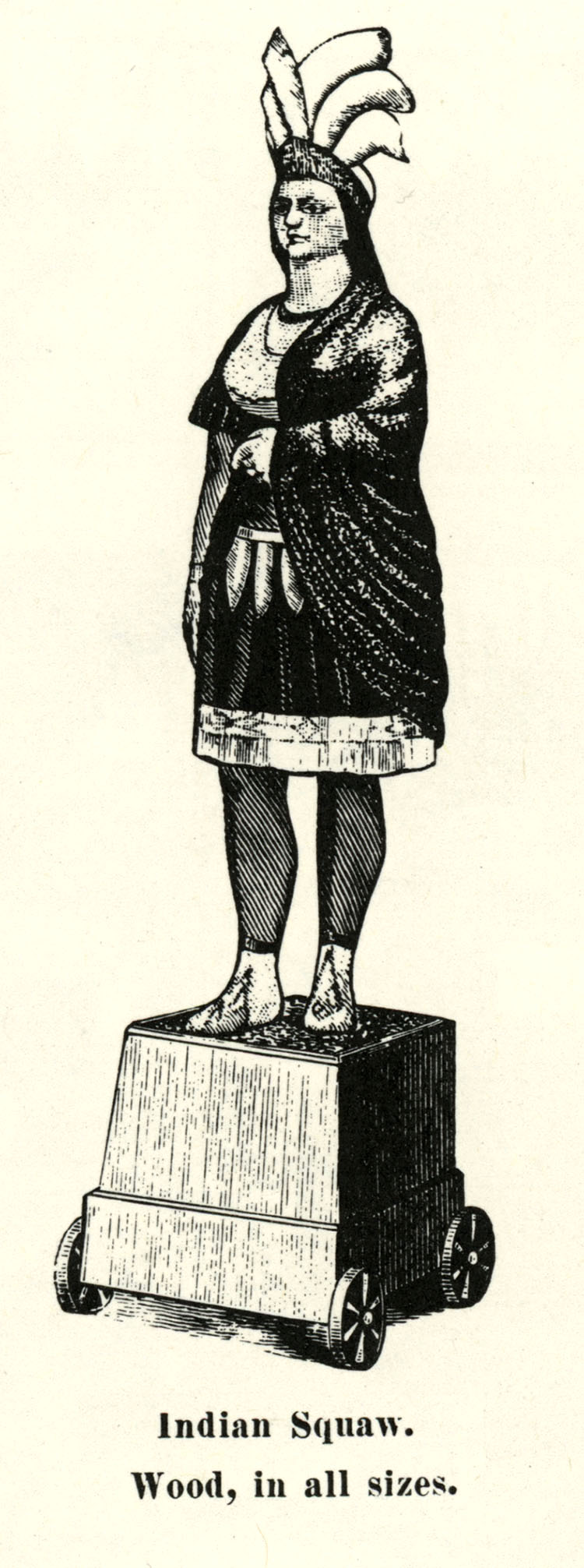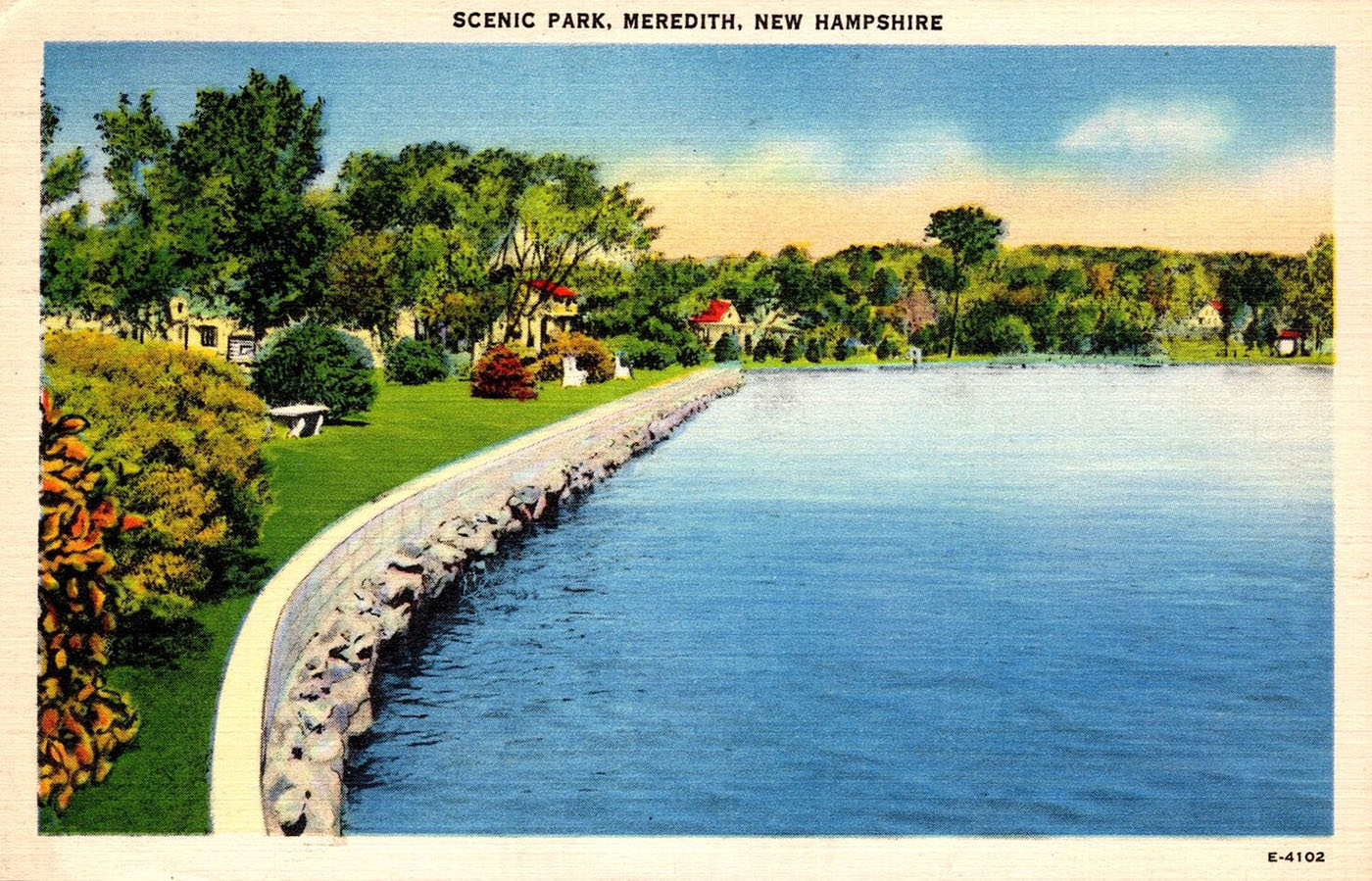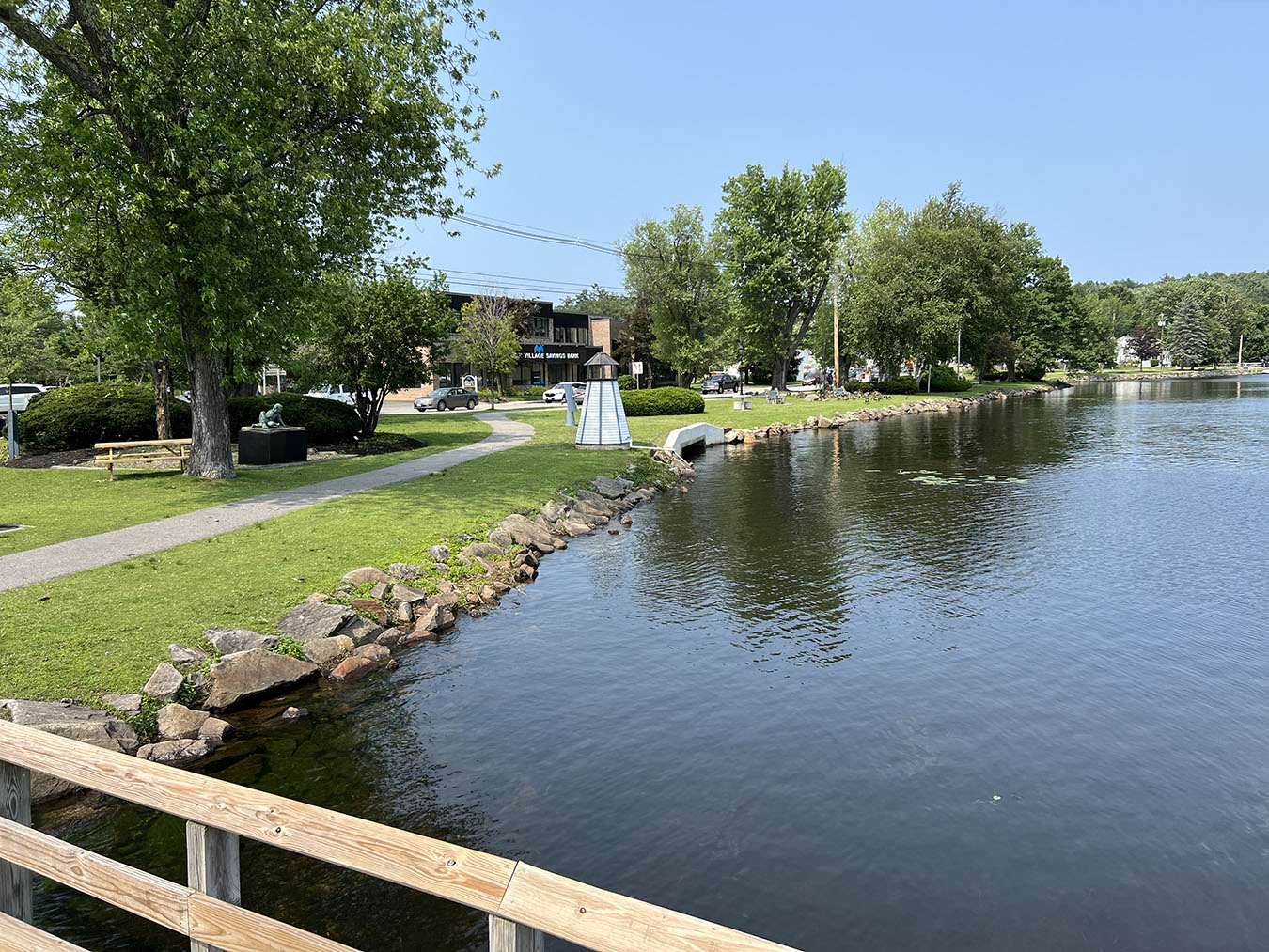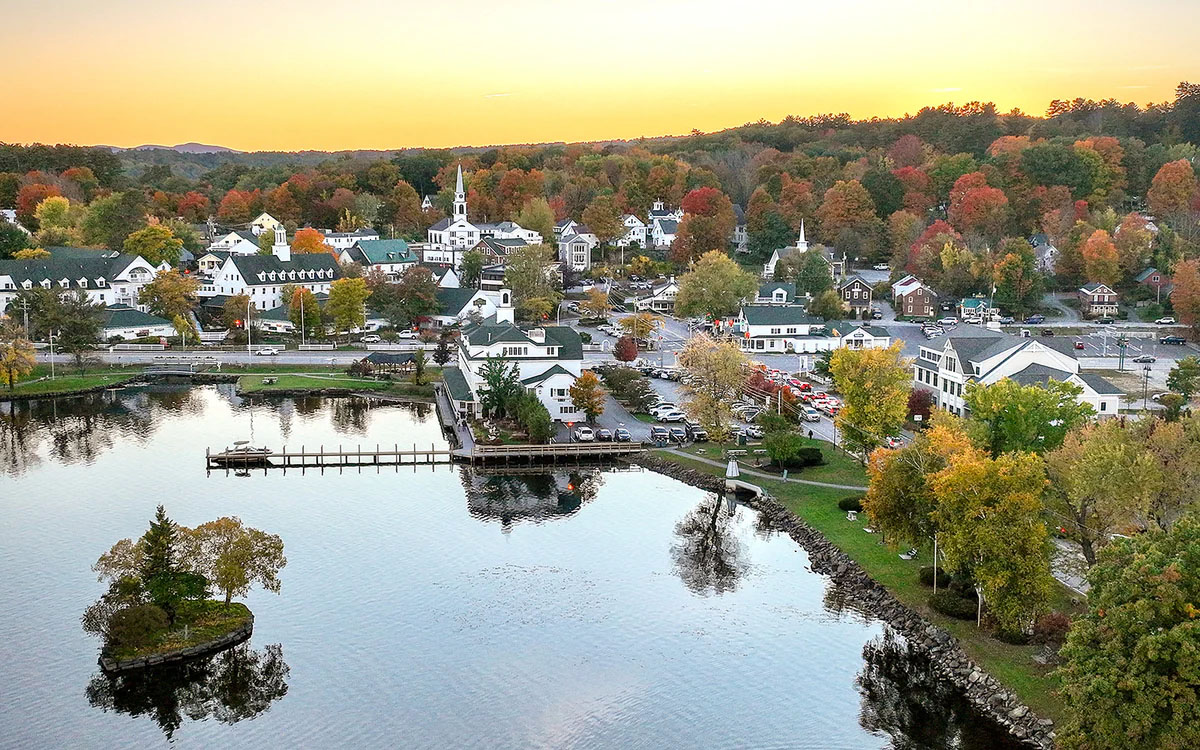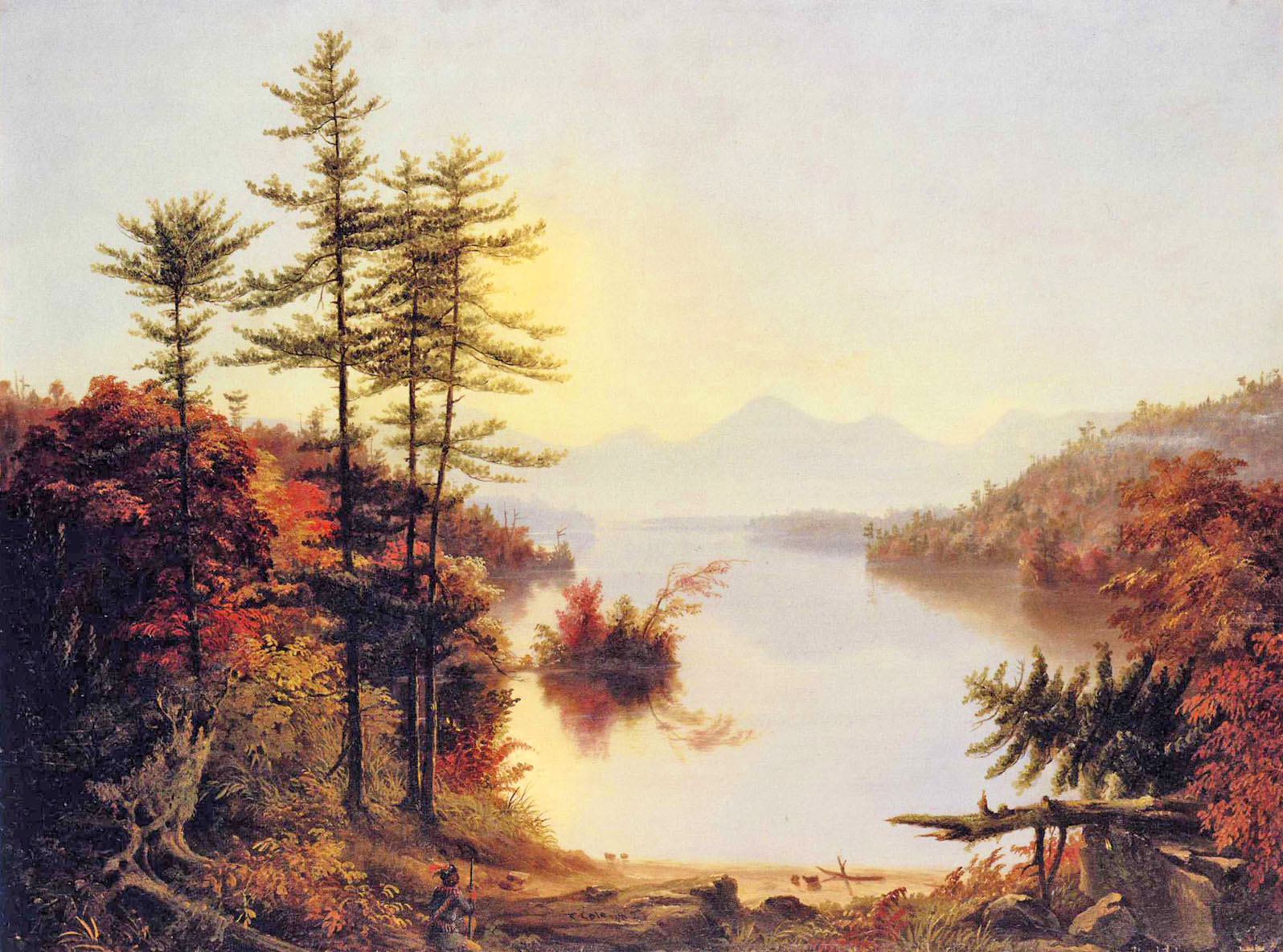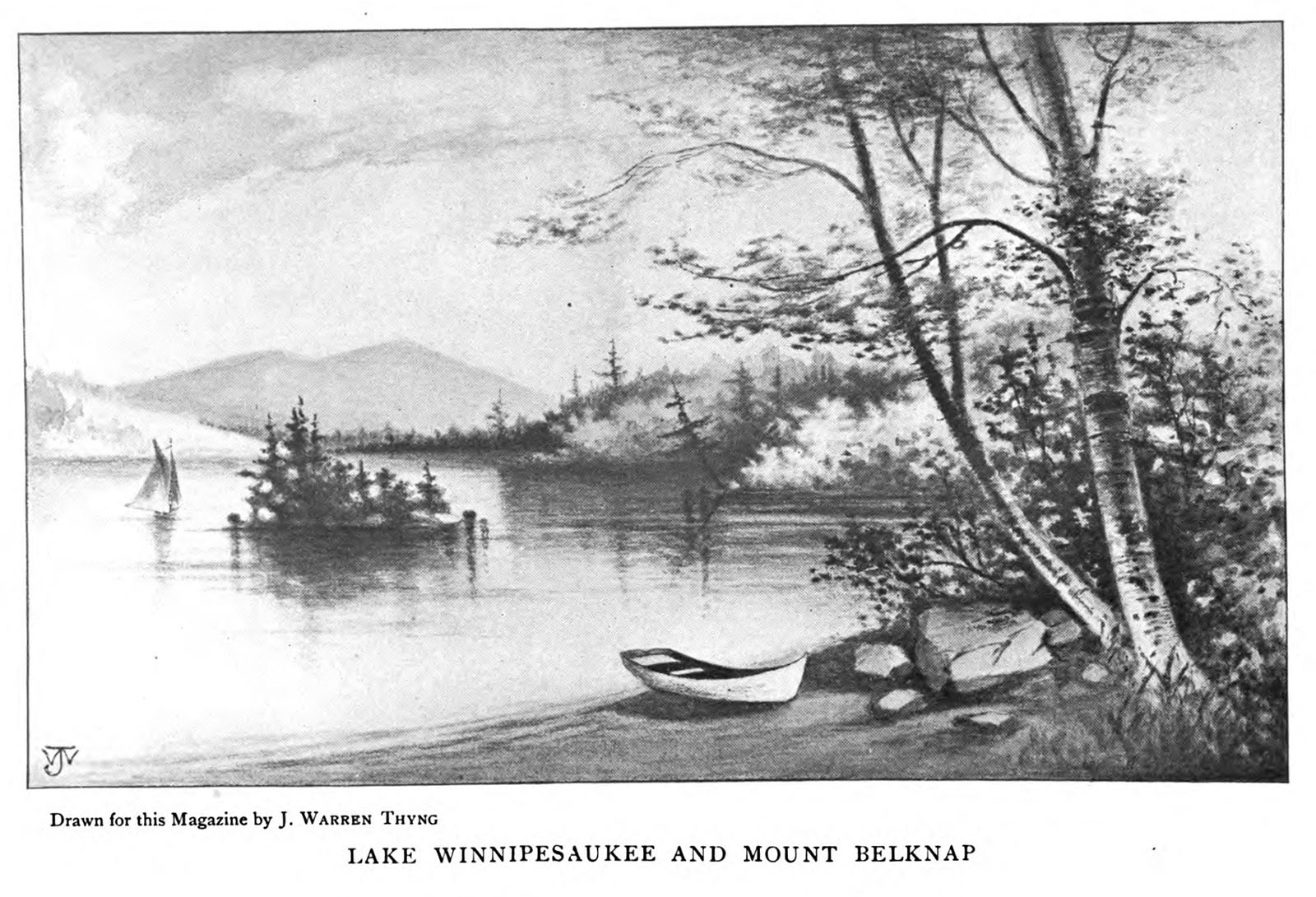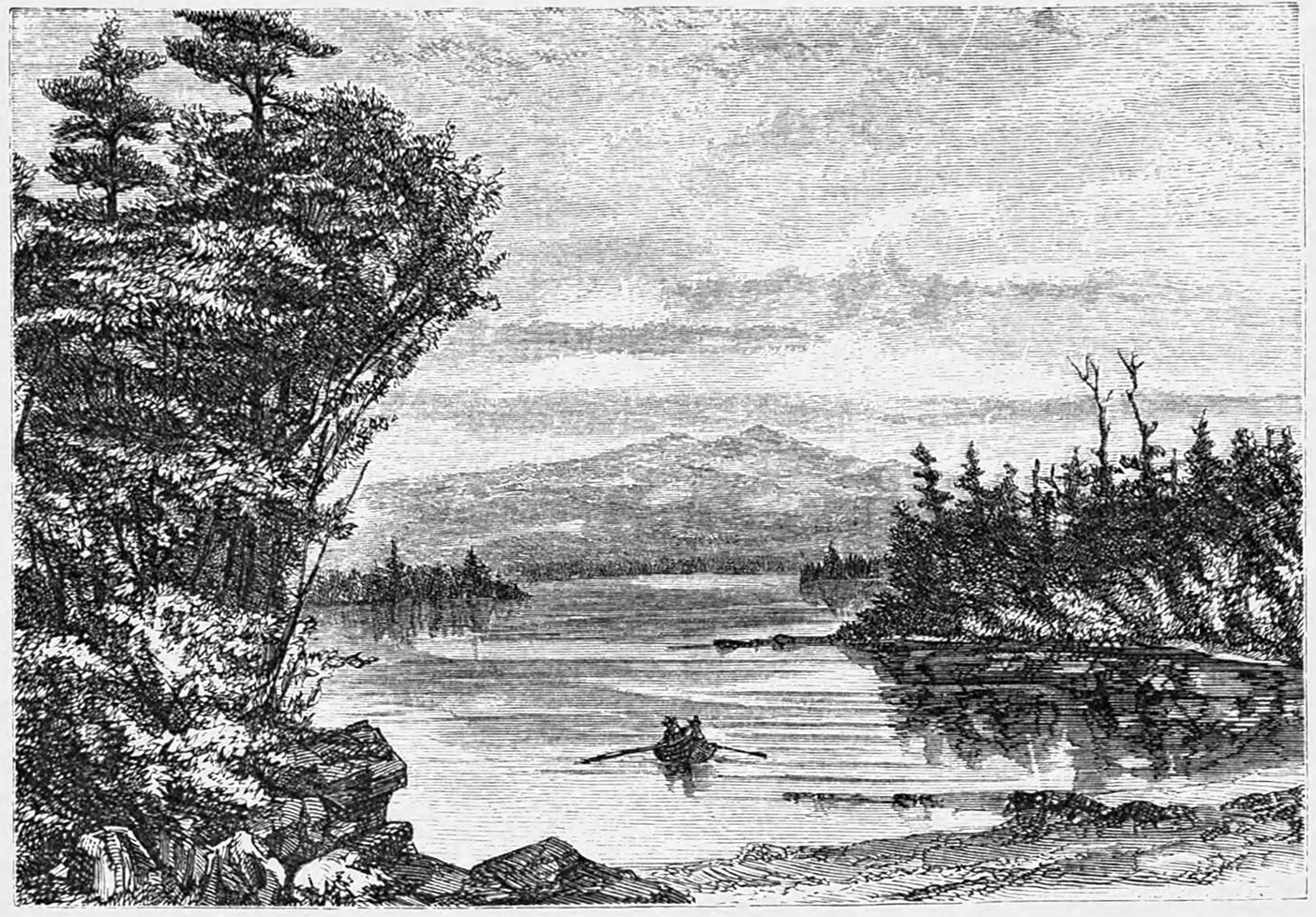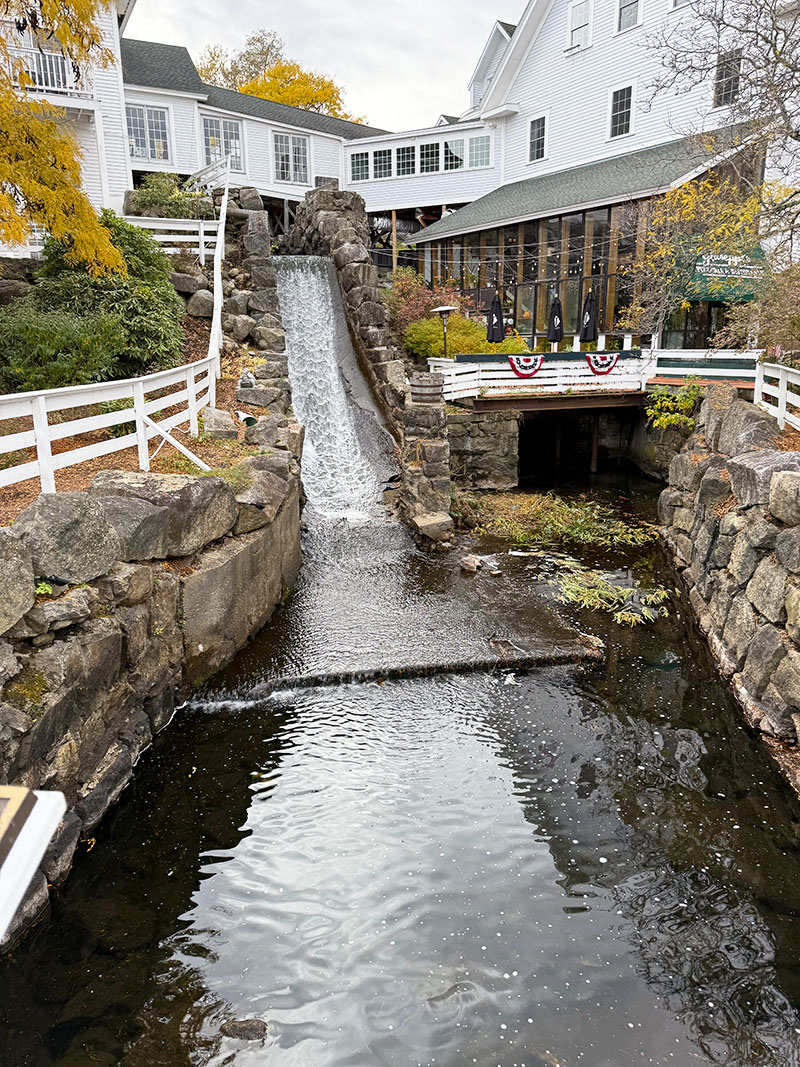Clough Park
Edward Hamlin Clough built Clough park in 1925. In 1924, Clough had purchased the 240 feet of lake frontage directly opposite the “Old Homestead” where he had been born. The shoreline was irregular, rough, and neglected. At that time, the Hawkins Brook wetland extended all the way to the lake, and Main Street crossed the wetland outlet by bridge before heading to Center Harbor. East of the bridge, Main Street has been renamed, and is now the start of the Whittier Highway, Route 25.
At one end of Clough’s lake frontage stood the locally prized, “Old Oak” landmark. Clough cleaned out the decayed wood from the interior of the great hollow within the tree’s trunk, filling it in with cement. He built a seawall around two sides of the tree, covered its exposed roots, and graded around the adjoining corner. The effort extended the life of the glorious old tree for decades. After it died, a new oak was planted in its place in 1992.
Detail from an 1889 map of Meredith shows an undeveloped shoreline where Clough Park would later be located. The Old Oak, drawn in at the Main Street fork intersection on the right, at what is now the intersection of Route 25 and Pleasant Street, is misplaced. The Old Oak was located on the far left of the undeveloped shoreline seen on the map. The bridge shown crossing the outlet of Hawkins Brook was located about where the Meredith traffic lights are today. The house-covered spit of land shown between Main Street and the lake is where the Bay Point hotel/Lago restaurant are today. In the late 1940s, the outlet of the brook was relocated to a point about halfway between the traffic lights and the fork intersection.
This old postcard, predating Clough Park, shows the Meredith waterfront still in its natural wetland state. The Old Oak is seen at the center of the postcard. The Main Street of the 1889 map has been renamed Winnipesaukee Street.
View from Clough Park, Meredith, N.H. Postmarked in 1945. Stones are seen placed along the waterfront retaining wall. The Old Oak tree is seen on the right.
The Mount Washington steams out of Meredith Bay between the supports of the Clough Park Gateway. The gateway arch was placed midway in the seawall. According to Clough, “The bronze eagle formerly adorned the bow of the warship Raleigh and witnessed the battle of Manila Bay under Admiral Dewey. At the end of the stone pier, directly in fron of the arch, is a pair of bronze herons, realistically posed.”
Deer statue at Clough Park. Clough writes, “The deer, in recumbent posture, at the west of the arch, came from ‘The Willows’, the river estate of Mrs. Frederick Smythe of Manchester, and was the appreciated gift from the widow of New Hampshire’s Civil War governor.” (It is unknown which governor Clough is referring to, as there were three different NH governors during the Civil War. Ichabod Goodwin was in office for a few months when the war started. Nathaniel S. Berry served from 1861-1863, and Joseph A. Gilmore served from 1863-1865.)
The Old Oak
The Old Oak predated Clough Park. Below are several old postcards showing the Old Oak.
Old Oak postcard with ladies. The Meredith Shook and Lumber Company can be seen across the bay, on what is now called Church Landing. The lumber company moved there in the early 1860s, and remained for about four decades.
The Old Oak in 1931. Photo from Clough’s book.
The Shook and Lumber Company sawmill was located on Swasey Point. (“Shooks” are the slats or boards that are stapled or nailed together to form a box.) In 1946, the Roman Catholic Diocese bought the property and built the St. Charles church on the site. In 2003, Rusty McLear acquired the property, tore down the church, and built Church Landing, a luxury hotel.
The Unique Stones
In 1927, a number of stones gathered over the decades by Seneca Ladd* were donated by Ladd’s daughter, Fannie, to be placed in Clough’s wall that ran the 240′ length of shorefront along the base of Meredith Bay. The stones were embedded into an upright position in the retaining wall. The stones were a variety of geological rarities, including pieces of meteorite, a chunk of the Greek Parthenon, a shoe-shaped rock from an Indian grave, and coral from the shore of Havana Harbor where the battleship Maine was sunk. The wall also included stones donated by famous people including Theodore Roosevelt, Calvin Coolidge and Herbert Hoover. Edward Clough, in his 1931 book, “The Story of Clough Park”, claimed the stones were from “23 states, three territories, the District of Columbia, and 15 foreign countries.” Clough provided a brief description of each and every one of the stones, as well as the circumference and height of each stone. There were 269 stones, separated into 15 sections, listed on the last 7 pages of his book.
One of the 15 sections of Clough’s guide to the unique stones, “On Indian Elevation”, provide the details as to the six stones that accompanied the Captain Jack Indian statue on his elevated base jutting from the Clough Park seawall. The base is seen below in this early 1960s color photo, sans the statue. The large black triangular stone was 21″ high by 19″ round. It was “veined”, and “showed where worn in the glacial period.” It was donated by Frank M. Frissell, and came from somewhere around Lake Winnipesaukee. The stone was pictured on the back cover of Clough’s book. The white stone was 14″ high by 19″ round and came from the Veasey Farm in Meredith. The tall red stone came from No. Attleboro, MA, and was donated by F.B. Honywill of Boston.
In 1964, the seawall was eroding and came under study of the town, but nothing was done. As the stones came loose, a few were given to the Meredith Historical Society. The rest were unaccounted for. Someone may have made off with a fortune. One of the stones was described by Clough as a “…75lb, black pitted meteor from Mt. Cube, Oxford, N.H. Seen fall by Geo. M. Williams of Warren, N.H.”. At 75lbs, an ordinary, stony chondrite meteorite would be worth $17,000-$170,000 today; a metallic, iron meteorite $34,000 to $340,000; and a crystalline pallasite, $680,000 to $3.4 million or more.
*Seneca Ladd was one of early Meredith’s most important business persons. His various businesses included carriage manufacturing, piano manufacturing, water power, and the founding of Meredith Village Savings Bank (MVSB), which still exists today. The MVSB recently erected the Seneca Ladd building right next to its home office on Route 25. Click here for a bio of Seneca Ladd.
The Four Statues
Besides the unique stones and the Old Oak, the other prominent feature of Clough Park were its four, cigar store Indian statues from Manchester, NH – in particular, its Captain Jack statue, which was a duplicate of the statue atop Weirs Beach’s Endicott Rock monument. It is not known what happened to the Meredith Captain Jack statue. It was probably removed in the early 1950s.
Clough called his Captain Jack statue “Hiawatha“. He writes, “Going to the east side of the arch, we find the valued figure of an Indian adorned with the feathered headdress and other characteristic habiliments of the Indian. For many years, this figure stood at the entrance of Hubbard’s cigar store, near the foot of Hanover street in Manchester.”
“Minnehaha” stood on a stone plinth across the street from the park. Clough writes, “With hand shading his eyes, who is Hiawatha looking at across the street? Minnehaha, of course. There she stands, and apparently unconscious (after the manner of a maiden) that her lover is peering at her. For a period of years this figure was an attraction at the entrance of a cigar store on Elm Street, near the foot of Bridge Street, in Manchester.”
On the lawn bordering the driveway of Clough’s home was “Pocahontas“. Said Clough, “Another dusky maiden is dressed and adorned as befitting her rank. This Indian princess was formerly the outside attraction of the original cigar store of ‘Sullivans 7-20-4 Cigar’, at 724 Elm Street in Manchester.”
Clough leaves the best for last. “Looking across the bay at the right, one sees a small island, upon which stands the lifesize figure of an Indian chieftain, posed in an aggressive attitude with bow and arrow in hand. ‘Chief Chocorua‘ for many years was a conspicuous feature on the bank of the Merrimack river at Manchester.”
See below for more info about the Captain Jack and Chief Chocorua statues. The Minnehaha and Pocahontas statues were located on Clough’s private property, not at the civic park, so they were probably sold off soon after Clough passed away.
Indian statue photos from Clough’s book, “The Story of Clough Park”
Hiawatha (Captain Jack)
This is the Captain Jack statue that was located in Clough Park. The postcard below showing the statue is of 1940s vintage. It is unknown which of the many stones shown in the postcard was the “Calvin Coolidge” stone of the postcard caption.
A color postcard of Clough Park postmarked in 1933. The red arrow reveals the location of the “Minnehaha” statue.
Chocorua (Indian Chief) and Indian Island
The Captain Jack statue was not the only Indian statue in Clough Park. Just a few feet away in Meredith Bay, another statue was placed on what became known as “Indian Island”. The island had been given to Meredith in 1924. The statue was donated by Edward Clough, and it was flanked by two giant iron anchors donated by Mount Washington Captain Sidney Baker. Until 1870, the anchors had been in use on the steamer Chocorua. The anchors provided inspiration for the name of the statue, Chief Chocorua, and the island’s formal name, Little Chocorua. One anchor weighed 656 lbs, and the other 443 lbs, according to Clough.
Several postcards, below, show the Chief Chocorua statue, but the statue cannot be seen in detail. The statue was said to have resembled the Chief Squantum statue in Tilton (see photo below), which has recently been restored, and is on display on the corner of Main Street and Park Street in Vest Pocket Park. The Chief Squantum statue is actually a cigar store Indian made of zinc alloy by the William Demuth Company of New York City. The Chief Chocorua was the same model cigar store Indian as well. The model was called the “Indian Chief”.
The Chief Chocorua statue met an untimely demise. Damaged by a shotgun blast after being used for target practice, the statue met its final fate after being struck by a snowmobile. Moved off the island and taken to the old town garage, the statue proved to be irreparably damaged and its remains were reportedly buried.
In the early 2000s, an effort to replace the statue was successful. The Indian Island Restoration Committee raised $58,000 to fund the creation of the bronze, and another $5,000 to restore the badly eroded island. Glenn Hines of Houlton, Maine and his wife, Diane, crafted the imposing 11,000-pound eight-foot tall replica. The replacement was a more historically accurate depiction of a Native American. The aggressive stance of the statue’s predecessor was softened, and the sculpture was enlarged to allow it to be more easily seen by passing boaters.
Marine contractor Dean Mason repaired the island and installed the statue. The island, with its crumbling stone wall, was eroding into the lake, held together by old cribwork beams from a past building. A 2,700 pound granite boulder served as the statue’s base. Stainless steel pins attached Chocorua to the boulder. Dean Mason was a personal friend of this website’s webmaster. Sadly, Dean passed away in 2016.
Indian Island, 1960s, before its restoration. The retaining wall around the island had badly eroded. A deer is seen in the middle of the island. Is this a real deer, or had the deer statue, which was previously perched on the stone wall of Clough Park, been moved to the island?
The new Chief Chocorua statue on Indian Island. Unlike the old statue, which stood in the wide open on a flat, manicured lawn, the new statue is tucked away on an island covered with bushes, scrub and trees. Photo taken on July 11, 2023.
The Meredith Sculpture Walk’s first sculpture was placed in 2013 at the Courtyard, on Main Street. The Walk has grown over the years to include multiple works along Main Street, on the grounds of the Mill Falls complex, the Meredith Public Library, the Baptist Church, and in the Hesky and Scenic lakeside parks. There is a limit of 32 sculptures, with most rotated on a yearly basis. The most popular sculptures remain for one additional year of public display before they term out and are replaced.
Engraving from the Willam Demuth Company “Illustrated Catalogue of Smokers’ Articles and Show Figures”. According to Frederick Fried, Indian Chief No. 53 was “…the most famous and popular of all the metal figures…” in the Demuth catalog. “An extremely large figure endowed with great dignity…the right hand holds an arrow, the left hand a bow. From the neck is hung a string of bear claws, a mark of bravery…”
Minnehaha (Indian Maiden)
The third of the four statues.
The Clough Park Minnehaha statue. In her left hand, she is carrying a cigar box, cigars out of the box, and a tobacco pipe; while in her right hand, she holds a sheaf of tobacco leaves. She wears a simple headdress.
Engraving from the Willam Demuth Company “Illustrated Catalogue of Smokers’ Articles and Show Figures”. According to Frederick Fried, Indian Maiden No. 56 was designed for tobacconists, but was also adapted for druggists. Fried explained, “The origin and meaning of the headdress is obscure, perhaps derived from an illustration of a brand of tobacco called La Africana, or after the opera “L’Africaine”…which may represent Selika, the opera queen.”
Pocahontas (Indian Squaw)
Pocahontas was perhaps the least valuable of the four Indian statues at Clough Park. While the three other statues (Captain Jack, Indian Chief and Indian Maiden) were all popular zinc statues from the Demuth catalog, Pocahontas was an “Indian Squaw”, wooden statue carved in the workshop of Thomas V. Brooks in Chicago. An illustration of the style can be found in the 1879 catalog issued by Metzler, Rothschild, & Co. Since wooden statues were hand carved, they could be easily customized to the whims of the customer; hence, there was more variation in the final product.
The Clough Park Pocahontas statue. In her left hand, she is carrying cigars; in her right hand, she holds a spear. The spear looks more medieval European in origin than Native American.
A painted wooden Indian Squaw statue from the Mark Goldman collection. In her left hand, instead of a bunch of cigars, she’s holding a large cigar box. In the right hand, instead of an upright spear, she’s holding a downward pointing blade.
Scenic Park
This old linen postcard renames Clough park as Scenic Park, its name today. The park is seen without its unique upright stones and statues. The seawall is portrayed with an upper brick facing above the stone masonry. This postcard is an artistic conception of an improved seawall, not a colored-in photograph. The upper brick facing was never built. The mortar binding together the stone masonry gradually deteriorated, and the seawall fell apart.
A contemporary photo of Scenic Park taken in July, 2023. The old solid seawall has crumbled into pieces. The relocated culvert outlet of Hawkins Brook can be seen in the middle of the photo.
An aerial photo of the center of Meredith includes an overhead view of Scenic Park and Indian Island. Photo by noted drone photographer John Gisis.
Artwork of Meredith Bay
Notice the similarities between the following 1960s postcard view of Meredith Bay, taken from Scenic Park, and the 1828 oil painting, “View on Lake Winnipiseogee” by famed White Mountain artist Thomas Cole. Cole’s picture was painted in his New York studio based on a sketch provided by his patron Daniel Wadsworth. Wadsworth had sketched the view down Meredith Bay from the shore at present Scenic Park, showing the Belknap Mountains in the distance. Writing to Wadsworth about the painting he had created, Cole said, “I have imagined it in its wild state — it is a morning view in Indian Summer.” To emphasize the wildness of nature, Cole often made the mountains around the lake appear much more craggy and steeper than they really were. (Daniel Heyduk, pgs 106-107 of Stories in the History of NH’s Lakes Region)
A sketch by artist J. Warren Thyng from his 1908 book, Reminiscences of the Poet Whittier, appears to also have been drawn from the head of Meredith Bay.
1860 Map
A map of Meredith Village, from an inset in an 1860 map of Belknap County, is probably the earliest detailed map of downtown Meredith available. The map shows how the outlet canal of Lake Waukewan, built in 1818, ran under Main Street and out to the “North West Cove” of the lake. The original outlet stream of Lake Waukewan is shown as a wavy line to a point to the left of the residence of “ABean”. Today that outlet would be to the left of Church Landing. The map also shows that the location of the steamboat landing was at the foot of Dover Street, just south of what is today’s Hesky Park.












